Green and Superior Adsorbents Derived from Natural Plant Gums for Removal of Contaminants: A Review
Abstract
1. Introduction
2. Natural Plant Gums
3. Natural Plant Gums-Derived Adsorbents
3.1. Guar Gum-Derived Adsorbents
3.1.1. Preparation of Guar Gum-Derived Adsorbents
3.1.2. Application for Capturing Heavy Metal Ions
3.1.3. Application for Capturing Dyes
3.1.4. Application for Capturing Bactericide
3.1.5. Application for Capturing Pesticides
3.1.6. Application for Oily Wastewater Purification
3.2. Xanthan Gum-Derived Adsorbents
3.2.1. Application for Capturing Heavy Metals
3.2.2. Application for Capturing Dyes
3.2.3. Application for Capturing Other Pollutants
3.3. Pectin-Derived Adsorbents
3.3.1. Application for Capturing Heavy Metal Ions
3.3.2. Application for Capturing Dyes
3.3.3. Application for Capturing Antibiotics and Other Organic Pollutants
3.4. Carrageenan Gum-Derived Adsorbents
3.4.1. Application for Capturing Heavy Metal Ions
3.4.2. Application for Capturing Dyes
3.4.3. Application for Capturing Pharmaceuticals
3.4.4. Application for Capturing Other Organic Pollutants
3.5. Adsorbents Derived from Arabic Gum
3.5.1. Application for Capturing Heavy Metal Ions
3.5.2. Application for Capturing Dyes
3.5.3. Application for Capturing Other Organic Pollutants
3.6. Welan Gum-Derived Adsorbents
3.7. Gellan Gum-Derived Adsorbents
3.8. Tara Gum-Derived Adsorbents
3.9. Gum Tragacanth-Derived Adsorbents
3.10. Karaya Gum-Derived Adsorbents
3.11. Gum Ghatti-Derived Adsorbents
3.12. Galactomannan Gum and Fenugreek Gum-Derived Adsorbents
4. Conclusions, Perspectives, and Future Perspectives
Author Contributions
Funding
Institutional Review Board Statement
Informed Consent Statement
Data Availability Statement
Acknowledgments
Conflicts of Interest
References
- Wang, T.; Jiang, M.; Yu, X.; Niu, N.; Chen, L. Application of lignin adsorbent in wastewater Treatment: A review. Sep. Purif. Technol. 2022, 302, 122116. [Google Scholar] [CrossRef]
- Salman, S.; Znad, H.; Hasan, N.; Hasan, M. Optimization of innovative composite sensor for Pb(II) detection and capturing from water samples. Microchem. J. 2021, 160, 105765. [Google Scholar] [CrossRef]
- Das, P.P.; Sharma, M.; Purkait, M.K. Recent progress on electrocoagulation process for wastewater treatment: A review. Sep. Purif. Technol. 2022, 292, 121058. [Google Scholar] [CrossRef]
- Hasan, M.N.; Salman, M.S.; Islam, A.; Znad, H.; Hasan, M.M. Sustainable composite sensor material for optical cadmium(II) monitoring and capturing from wastewater. Microchem. J. 2021, 161, 105800. [Google Scholar] [CrossRef]
- Zhang, L.; Meng, Y.; Dai, T.; Yao, Y.; Shen, H.; Xie, B.; Ni, Z.; Xia, S. Fabrication of a coated BiVO4@LDHs Z-scheme heterojunction and photocatalytic degradation of norfloxacin. Appl. Clay Sci. 2022, 219, 106435. [Google Scholar] [CrossRef]
- Hu, X.L.; Li, C.Q.; Song, J.Y.; Zheng, S.L.; Sun, Z.M. Hierarchical assembly of visible-light-driven Bi2MoO6/TiO2/sepiolite composite for effective formaldehyde removal. Appl. Clay Sci. 2022, 227, 106590. [Google Scholar] [CrossRef]
- Li, S.; Kang, Y. Effect of PO43- on the polymerization of polyferric phosphatic sulfate and its flocculation characteristics for different simulated dye wastewater. Sep. Purif. Technol. 2021, 276, 119373. [Google Scholar] [CrossRef]
- Singh, S.; Pandey, J.; Sen, G. Microwave assisted synthesis of guar gum based biopolymeric macromolecule optimized as a flocculant for mineral ore processing. Int. J. Biol. Macromol. 2022, 220, 307–315. [Google Scholar] [CrossRef]
- Wang, C.; Liu, Y.; Huang, M.; Xiang, W.; Wang, Z.; Wu, X.; Zan, F.; Zhou, T. A rational strategy of combining Fenton oxidation and biological processes for efficient nitrogen removal in toxic coking wastewater. Bioresour. Technol. 2022, 363, 127897. [Google Scholar] [CrossRef]
- Han, L.; Wang, Y.; Zhao, W.; Zhang, H.; Guo, F.; Wang, T.; Wang, W. Cost-effective and eco-friendly superadsorbent derived from natural calcium-rich clay for ultra-efficient phosphate removal in diverse waters. Sep. Purif. Technol. 2022, 297, 121516. [Google Scholar] [CrossRef]
- Qiu, B.; Shao, Q.; Shi, J.; Yang, C.; Chu, H. Application of biochar for the adsorption of organic pollutants from wastewater: Modification strategies, mechanisms and challenges. Sep. Purif. Technol. 2022, 300, 121925. [Google Scholar] [CrossRef]
- He, Q.D.; Liu, X.Y.; Wang, Y.W.; Ding, K.; Ge, H.W.; Xie, C.Z.; Wang, W.B.; Guo, F. Circular conversion of waste rectorite@dye to efficient and pH-resistant heterogeneous silicate adsorbents for cyclic and complete dye removal. Appl. Clay Sci. 2022, 225, 106556. [Google Scholar] [CrossRef]
- Jun, B.-M.; Lee, H.-K.; Park, S.; Kim, T.-J. Purification of uranium-contaminated radioactive water by adsorption: A review on adsorbent materials. Sep. Purif. Technol. 2021, 278, 119675. [Google Scholar] [CrossRef]
- Wang, Y.; Liu, X.; He, Q.; Lu, H.; Guo, F.; Zhang, Y.; Wang, W. One-step efficient separation of heavy/light oils, dyes and water by simple filtration with a 3D architecture of functional mesh and sisal fiber felt. Sep. Purif. Technol. 2022, 286, 120461. [Google Scholar] [CrossRef]
- Vásquez, L.; Dziza, K.; Loo, S.-L.; Binas, V.; Stefa, S.; Kiriakidis, G.; Athanassiou, A.; Fragouli, D. Highly performant nanocomposite cryogels for multicomponent oily wastewater filtration. Sep. Purif. Technol. 2022, 303, 122252. [Google Scholar] [CrossRef]
- Wang, Y.; Liu, X.; He, Q.; Wang, X.; Lu, H.; Guo, F.; Zhang, Y.; Wang, W. Multifunctional natural sepiolite nanofibre composite demulsifiers for efficient purification of oils and dyes in simulated and actual wastewater. Sep. Purif. Technol. 2022, 290, 120865. [Google Scholar] [CrossRef]
- Lin, Z.H.; Huang, J.G. A hierarchical H3PW12O40/TiO2 nanocomposite with cellulose as scaffold for photocatalytic degradation of organic pollutants. Sep. Purif. Technol. 2021, 264, 118427. [Google Scholar] [CrossRef]
- Wang, Z.C.; Wen, B.Y.; Zhou, J.; Zhao, X.; Zhang, X.Y.; Su, Z.Q. Heterostructured ZnCdS@ZIF-67 as a photocatalyst for fluorescent dye degradation and selectively nonenzymatic sensing of dopamine. Materials 2022, 15, 7683. [Google Scholar] [CrossRef]
- Zhang, Y.; Zhang, Z.; Han, H.; Zhang, M.; Wang, H.; Song, H.; Chen, Y. Effective removal of organic dyes using the ultrasonic-assisted hydrothermal synthesis of NaP zeolite doping Cu or Fe in Fenton-like oxidation systems. Sep. Purif. Technol. 2022, 299, 121767. [Google Scholar] [CrossRef]
- Li, J.; Ma, W.; Zhong, D.; Li, K.; Ma, J.; Zhang, S.; Du, X. Oxygen vacancy concentration modulation of perovskite-based heterogeneous catalysts for Fenton-like oxidation of tetracycline. J. Clean. Prod. 2022, 362, 132469. [Google Scholar] [CrossRef]
- Wang, W.; Wang, F.; Kang, Y.; Wang, A. Au nanoparticles decorated Kapok fiber by a facile noncovalent approach for efficient catalytic decoloration of Congo Red and hydrogen production. Chem. Eng. J. 2014, 237, 336–343. [Google Scholar] [CrossRef]
- Wang, W.; Wang, F.; Kang, Y.; Wang, A. Facile self-assembly of Au nanoparticles on a magnetic attapulgite/Fe3O4 composite for fast catalytic decoloration of dye. RSC Adv. 2013, 3, 11515–11520. [Google Scholar] [CrossRef]
- Mallakpour, S.; Azadi, E.; Dinari, M. Novel mesoporous cupric oxide-based biomaterial: An efficient nanocatalyst toward catalytic reduction of emerging contaminants in the wastewater. J. Clean. Prod. 2022, 378, 134527. [Google Scholar] [CrossRef]
- Xiao, Y.; Shen, Y.; Ji, B. Cultivation of microalgal-bacterial granular sludge from activated sludge via granule inoculation: Performance and microbial community. J. Clean. Prod. 2022, 380, 134875. [Google Scholar] [CrossRef]
- Assad, H.; Fatma, I.; Kumar, A.; Kaya, S.; Vo, D.-V.N.; Al-Gheethi, A.; Sharma, A. An overview of MXene-Based nanomaterials and their potential applications towards hazardous pollutant adsorption. Chemosphere 2022, 298, 134221. [Google Scholar] [CrossRef]
- Wang, W.; Tian, G.; Zhang, Z.; Wang, A. A simple hydrothermal approach to modify palygorskite for high-efficient adsorption of Methylene blue and Cu(II) ions. Chem. Eng. J. 2015, 265, 228–238. [Google Scholar] [CrossRef]
- Yang, J.; Chen, X.; Zhang, J.; Wang, Y.; Wen, H.; Xie, J. Role of chitosan-based hydrogels in pollutants adsorption and freshwater harvesting: A critical review. Int. J. Biol. Macromol. 2021, 189, 53–64. [Google Scholar] [CrossRef]
- Liu, M.; Zang, Z.; Zhang, S.; Ouyang, G.; Han, R. Enhanced fluoride adsorption from aqueous solution by zirconium (IV)-impregnated magnetic chitosan graphene oxide. Int. J. Biol. Macromol. 2021, 182, 1759–1768. [Google Scholar] [CrossRef]
- Pooresmaeil, M.; Namazi, H. Chitosan coated Fe3O4@Cd-MOF microspheres as an effective adsorbent for the removal of the amoxicillin from aqueous solution. Int. J. Biol. Macromol. 2021, 191, 108–117. [Google Scholar] [CrossRef]
- Li, Y.; Dong, X.; Zhao, L. Application of magnetic chitosan nanocomposites modified by graphene oxide and polyethyleneimine for removal of toxic heavy metals and dyes from water. Int. J. Biol. Macromol. 2021, 192, 118–125. [Google Scholar] [CrossRef]
- Wang, W.; Liu, X.; Wang, X.; Zong, L.; Kang, Y.; Wang, A. Fast and Highly Efficient Adsorption Removal of Toxic Pb(II) by a Reusable Porous Semi-IPN Hydrogel Based on Alginate and Poly(Vinyl Alcohol). Front. Chem. 2021, 9, 662482. [Google Scholar] [CrossRef] [PubMed]
- Wang, X.; Zhang, H.; He, Q.; Xing, H.; Feng, K.; Guo, F.; Wang, W. Core-shell alginate beads as green reactor to synthesize grafted composite beads to efficiently boost single/co-adsorption of dyes and Pb(II). Int. J. Biol. Macromol. 2022, 206, 10–20. [Google Scholar] [CrossRef] [PubMed]
- Awual, M.R. A novel facial composite adsorbent for enhanced copper(II) detection and removal from wastewater. Chem. Eng. J. 2015, 266, 368–375. [Google Scholar] [CrossRef]
- Han, R.; Zhao, M.; Li, X.; Cui, S.; Yang, J. N-doped regular octahedron MOF-199 derived porous carbon for ultra-efficient adsorption of oxytetracycline. Sep. Purif. Technol. 2022, 302, 121960. [Google Scholar] [CrossRef]
- Yang, J.; Xiao, Q.; Jia, X.; Li, Y.; Wang, S.; Song, H. Enhancement of wastewater treatment by underwater superelastic fiber-penetrated lamellar monolith. J. Hazard. Mater. 2021, 403, 124016. [Google Scholar] [CrossRef]
- Zhao, W.; Zhang, H.; He, Q.; Han, L.; Wang, T.; Guo, F.; Wang, W. Controllable synthesis of porous silicate@carbon heterogeneous composite from Coal Gangue waste as eco-friendly superior scavenger of dyes. J. Clean. Prod. 2022, 363, 132466. [Google Scholar] [CrossRef]
- Wang, W.; Lu, T.; Chen, Y.; Tian, G.; Sharma, V.K.; Zhu, Y.; Zong, L.; Wang, A. Mesoporous silicate/carbon composites derived from dye-loaded palygorskite clay waste for efficient removal of organic contaminants. Sci. Total. Environ. 2019, 696, 133955. [Google Scholar] [CrossRef]
- Li, Y.; Tian, G.; Chen, B.; Liang, J. Self-templating construction of flower-like mesoporous magnesium silicate composites from sepiolite for high-efficiency adsorption of aflatoxin B1. Sep. Purif. Technol. 2022, 291, 120953. [Google Scholar] [CrossRef]
- Wang, W.; Zhao, W.; Zhang, H.; Xu, J.; Zong, L.; Kang, Y.; Wang, A. Mesoporous polymetallic silicate derived from naturally abundant mixed clay: A potential robust adsorbent for removal of cationic dye and antibiotic. Powder Technol. 2021, 390, 303–314. [Google Scholar] [CrossRef]
- Tian, G.Y.; Wang, W.B.; Zong, L.; Kang, Y.R.; Wang, A.Q. A functionalized hybrid silicate adsorbent derived from naturally abundant low-grade palygorskite clay for highly efficient removal of hazardous antibiotics. Chem. Eng. J. 2016, 293, 376–385. [Google Scholar] [CrossRef]
- Zhang, H.; He, Q.; Zhao, W.; Guo, F.; Han, L.; Wang, W. Superior dyes removal by a recyclable magnetic silicate@Fe3O4 adsorbent synthesized from abundant natural mixed clay. Chem. Eng. Res. Des. 2021, 175, 272–282. [Google Scholar] [CrossRef]
- Yi, Y.; Tu, G.; Ying, G.; Fang, Z.; Tsang, E.P. Magnetic biochar derived from rice straw and stainless steel pickling waste liquor for highly efficient adsorption of crystal violet. Bioresour. Technol. 2021, 341, 125743. [Google Scholar] [CrossRef] [PubMed]
- Kern, M.; Škulj, S.; Rožman, M. Adsorption of a wide variety of antibiotics on graphene-based nanomaterials: A modelling study. Chemosphere 2022, 296, 134010. [Google Scholar] [CrossRef] [PubMed]
- Karimi, S.; Nama-zi, H. Magnetic alginate/glycodendrimer beads for efficient removal of tetracycline and amoxicillin from aqueous solutions. Int. J. Biol. Macromol. 2021, 205, 128–140. [Google Scholar] [CrossRef] [PubMed]
- Xing, Y.; Li, Q.; Chen, X.; Li, M.; Wang, S.; Li, Y.; Wang, T.; Sun, X.; Li, X. Preparation of isoelectric point-switchable polymer brush-grafted mesoporous silica using RAFT polymerization with high performance for Ni(II) adsorption. Powder Technol. 2022, 412, 117980. [Google Scholar] [CrossRef]
- Qu, Y.; Qin, L.; Liu, X.G.; Yang, Y.Z. Magnetic Fe3O4/ZIF-8 composite as an effective and recyclable adsorbent for phenol adsorption from wastewater. Sep. Purif. Technol. 2022, 294, 121169. [Google Scholar] [CrossRef]
- Wen, Y.; Xie, Z.; Xue, S.; Long, J.; Shi, W.; Liu, Y. Preparation of novel polymethacryloyl hydrazone modified sodium alginate porous adsorbent with good stability and selective adsorption capacity towards metal ions. Sep. Purif. Technol. 2022, 303, 122184. [Google Scholar] [CrossRef]
- Wang, W.; Wang, A. Perspectives on green fabrication and sustainable utilization of adsorption materials for wastewater treatment. Chem. Eng. Res. Des. 2022, 187, 541–548. [Google Scholar] [CrossRef]
- Kalia, S.; Sabaa, M.W. Polysaccharide Based Graft Copolymers; Springer-Verlag Berlin and Heidelberg GmbH & Co.: Berlin/Heidelberg, Germany, 2013. [Google Scholar]
- Pilnik, W.; Rombouts, F.M. Polysaccharides and food processing. Carbohydr. Res. 1985, 142, 93–105. [Google Scholar] [CrossRef]
- Makhado, E.; Pandey, S.; Ramontja, J. Microwave-assisted green synthesis of xanthan gum grafted diethylamino ethyl methacrylate: An efficient adsorption of hexavalent chromium. Carbohydr. Polym. 2019, 222, 114989. [Google Scholar] [CrossRef]
- Guan, Y.; Yu, C.; Zang, Z.; Wan, X.; Naeem, A.; Zhang, R.; Zhu, W. Chitosan/xanthan gum-based (Hydroxypropyl methylcellulose-co-2-Acrylamido-2-methylpropane sulfonic acid) interpenetrating hydrogels for controlled release of amorphous solid dispersion of bioactive constituents of Pueraria lobatae. Int. J. Biol. Macromol. 2023, 224, 380–395. [Google Scholar] [CrossRef] [PubMed]
- Gohari, R.M.; Safarnia, M.; Koohi, A.D.; Salehi, M.B. Adsorptive removal of cationic dye by synthesized sustainable xanthan gum-g-p(AMPS-co-AAm) hydrogel from aqueous media: Optimization by RSM-CCD model. Chem. Eng. Res. Des. 2022, 188, 714–728. [Google Scholar] [CrossRef]
- Maji, B.; Maiti, S. Chemical modification of xanthan gum through graft copolymerization: Tailored properties and potential applications in drug delivery and wastewater treatment. Carbohydr. Polym. 2021, 251, 117095. [Google Scholar] [CrossRef] [PubMed]
- Saya, L.; Malik, V.; Singh, A.; Singh, S.; Gambhir, G.; Singh, W.R.; Chandra, R.; Hooda, S. Guar gum based nanocomposites: Role in water purification through efficient removal of dyes and metal ions. Carbohydr. Polym. 2021, 261, 117851. [Google Scholar] [CrossRef] [PubMed]
- Kulal, P.; Badalamoole, V. Evaluation of gum ghatti-g-poly(itaconic acid) magnetite nanocomposite as an adsorbent material for water purification. Int. J. Biol. Macromol. 2021, 193, 2232–2242. [Google Scholar] [CrossRef] [PubMed]
- Rana, V.; Rai, P.; Tiwary, A.K.; Singh, R.S.; Kennedy, J.F.; Knill, C.J. Modified gums: Approaches and applications in drug delivery. Carbohydr. Polym. 2011, 83 Pt B, 1031–1047. [Google Scholar] [CrossRef]
- Mittal, H.; Al Alili, A.; Morajkar, P.P.; Alhassan, S.M. Graphene oxide crosslinked hydrogel nanocomposites of xanthan gum for the adsorption of crystal violet dye. J. Mol. Liq. 2021, 323, 115034. [Google Scholar] [CrossRef]
- Ranjbar-Mohammadi, M.; Rahimdokht, M.; Pajootan, E. Low cost hydrogels based on gum Tragacanth and TiO2 nanoparticles: Characterization and RBFNN modelling of methylene blue dye removal. Int. J. Biol. Macromol. 2019, 134, 967–975. [Google Scholar] [CrossRef]
- Abu Elella, M.H.; Sabaa, M.W.; ElHafeez, E.A.; Mohamed, R.R. Crystal violet dye removal using crosslinked grafted xanthan gum. Int. J. Biol. Macromol. 2019, 137, 1086–1101. [Google Scholar] [CrossRef]
- Wang, F.; Wang, W.; Zhu, Y.; Wang, A. Evaluation of Ce(III) and Gd(III) adsorption from aqueous solution using CTS-g-(AA-co-SS)/ISC hybrid hydrogel adsorbent. J. Rare Earth 2017, 35, 697–708. [Google Scholar] [CrossRef]
- Wu, Y.Y.; An, Y.Y.; Zhai, J.; Liu, B.Z.; Zhang, W.Z.; Li, H.; Zheng, H.L. Versatile magnetic adsorbent based on sodium p-styrenesulfonate modified sodium alginate composite for effective capture of antibiotic ciprofloxacin, methylene blue and copper ion. J. Clean. Prod. 2022, 373, 133651. [Google Scholar] [CrossRef]
- Mudgil, D.; Barak, S.; Khatkar, B.S. Guar gum: Processing, properties and food applications—A Review. J. Food Sci. Technol. 2014, 51, 409–418. [Google Scholar] [CrossRef] [PubMed]
- Fetouh, H.; Hefnawy, A.; Attia, A.; Ali, E. Facile and low-cost green synthesis of eco-friendly chitosan-silver nanocomposite as novel and promising corrosion inhibitor for mild steel in chilled water circuits. J. Mol. Liq. 2020, 319, 114355. [Google Scholar] [CrossRef]
- Mukherjee, S.; Mukhopadhyay, S.; Bin Zafri, M.Z.; Zhan, X.; Hashim, M.A.; Gupta, B.S. Application of guar gum for the removal of dissolved lead from wastewater. Ind. Crop Prod. 2018, 111, 261–269. [Google Scholar] [CrossRef]
- Caldera-Villalobos, M.; Cabrera-Munguía, D.A.; Flores-Guía, T.E.; Viramontes-Gamboa, G.; Vargas-Correa, J.A.; Cano-Salazar, L.F.; Claudio-Rizo, J.A. Removal of water pollutants using composite hydrogels comprised of collagen, guar gum, and metal-organic frameworks. J. Polym. Res. 2021, 28, 395. [Google Scholar] [CrossRef]
- Mubark, A.E.; Hakem, H.A.; Zaki, E.G.; Elsaeed, S.M.; Abdel-Rahman, A.A.-H. Sequestration of Cd(II) and Cu(II) ions using bio-based hydrogel: A study on the adsorption isotherms and kinetics. Int. J. Environ. Sci. Technol. 2022, 19, 10877–10892. [Google Scholar] [CrossRef]
- Maity, J.; Ray, S.K. Enhanced adsorption of Cr(VI) from water by guar gum based composite hydrogels. Int. J. Biol. Macromol. 2016, 89, 246–255. [Google Scholar] [CrossRef]
- Fosso-Kankeu, E.; Waanders, F.; Maloy, E. Copolymerization of ethyl acrylate onto guar gum for the adsorption of Mg(II) and Ca(II) ions. Desalination Water Treat. 2016, 57, 26484–26493. [Google Scholar] [CrossRef]
- El Batouti, M.; Sadik, W.; Eldemerdash, A.G.; Hanafy, E.; Fetouh, H.A. New and innovative microwave-assisted technology for synthesis of guar gum-grafted acrylamide hydrogel superabsorbent for the removal of acid red 8 dye from industrial wastewater. Polym. Bull. 2022, 1–25. [Google Scholar] [CrossRef]
- Chami, S.; Joly, N.; Bocchetta, P.; Martin, P.; Aliouche, D. Polyacrylamide Grafted Xanthan: Microwave-Assisted Synthesis and Rheological Behavior for Polymer Flooding. Polymers 2021, 13, 1484. [Google Scholar] [CrossRef]
- Mohammadinejad, R.; Maleki, H.; Larrañeta, E.; Fajardo, A.R.; Nik, A.B.; Shavandi, A.; Sheikhi, A.; Ghorbanpour, M.; Farokhi, M.; Govindh, P.; et al. Status and future scope of plant-based green hydrogels in biomedical engineering. Appl. Mater. Today 2019, 16, 213–246. [Google Scholar] [CrossRef]
- Damiri, F.; Andra, S.; Kommineni, N.; Balu, S.K.; Bulusu, R.; Boseila, A.A.; Akamo, D.O.; Ahmad, Z.; Khan, F.S.; Rahman, H.; et al. Recent Advances in Adsorptive Nanocomposite Membranes for Heavy Metals Ion Removal from Contaminated Water: A Comprehensive Review. Materials 2022, 15, 5392. [Google Scholar] [CrossRef] [PubMed]
- Masoumi, H.; Ghaemi, A.; Gilani, H.G. Evaluation of hyper-cross-linked polymers performances in the removal of hazardous heavy metal ions: A review. Sep. Purif. Technol. 2021, 260, 118221. [Google Scholar] [CrossRef]
- Zhang, P.; Zou, K.; Yuan, L.; Liu, J.; Liu, B.; Qing, T.-P.; Feng, B. A biomass resource strategy for alginate-polyvinyl alcohol double network hydrogels and their adsorption to heavy metals. Sep. Purif. Technol. 2022, 301, 122050. [Google Scholar] [CrossRef]
- Wang, J.; Wang, W.; Ai, Z.; Li, M.; Li, H.; Peng, W.; Zhao, Y.; Song, S. Adsorption toward Pb(II) occurring on three-dimensional reticular-structured montmorillonite hydrogel surface. Appl. Clay Sci. 2021, 210, 106153. [Google Scholar] [CrossRef]
- Wiśniewska, M.; Marciniak, M.; Gęca, M.; Herda, K.; Pietrzak, R.; Nowicki, P. Activated Biocarbons Obtained from Plant Biomass as Adsorbents of Heavy Metal Ions. Materials 2022, 15, 5856. [Google Scholar] [CrossRef] [PubMed]
- Zeng, H.; Zeng, H.; Zhang, H.; Shahab, A.; Zhang, K.; Lu, Y.; Nabi, I.; Naseem, F.; Ullah, H. Efficient adsorption of Cr (VI) from aqueous environments by phosphoric acid activated eucalyptus biochar. J. Clean. Prod. 2021, 286, 124964. [Google Scholar] [CrossRef]
- Ma, R.; Yan, X.; Pu, X.; Fu, X.; Bai, L.; Du, Y.; Cheng, M.; Qian, J. An exploratory study on the aqueous Cr(VI) removal by the sulfate reducing sludge-based biochar. Sep. Purif. Technol. 2021, 276, 119314. [Google Scholar] [CrossRef]
- Xiong, Z.; Zheng, H.; Hu, Y.; Hu, X.; Ding, W.; Ma, J.; Li, Y. Selective adsorption of Congo red and Cu(II) from complex wastewater by core-shell structured magnetic carbon@zeolitic imidazolate frameworks-8 nanocomposites. Sep. Purif. Technol. 2021, 277, 119053. [Google Scholar] [CrossRef]
- Li, M.; Zhang, S.; Cui, S.; Qin, K.; Zhang, Y.; Li, P.; Cao, Q.; Xiao, H.; Zeng, Q. Pre-grafting effect on improving adsorption efficiency of cellulose based biosorbent for Hg (II) removal from aqueous solution. Sep. Purif. Technol. 2021, 277, 119493. [Google Scholar] [CrossRef]
- Bobik, M.; Korus, I.; Synoradzki, K.; Wojnarowicz, J.; Biniaś, D.; Biniaś, W. Poly(sodium acrylate)-modified magnetite nanoparticles for separation of heavy metals from aqueous solutions. Materials 2022, 15, 6562. [Google Scholar] [CrossRef] [PubMed]
- Zheng, M.; Wei, Y.; Ren, J.; Dai, B.; Luo, W.; Ma, M.; Li, T.; Ma, Y. 2-aminopyridine functionalized magnetic core–shell Fe3O4@polypyrrole composite for removal of Mn (VII) from aqueous solution by double-layer adsorption. Sep. Purif. Technol. 2021, 277, 119455. [Google Scholar] [CrossRef]
- Liu, X.; Yang, S.; Gu, P.; Liu, S.; Yang, G. Adsorption and removal of metal ions by smectites nanoparticles: Mechanistic aspects, and impacts of charge location and edge structure. Appl. Clay Sci. 2021, 201, 105957. [Google Scholar] [CrossRef]
- Wang, W.B.; Tian, G.Y.; Zhang, Z.F.; Wang, A.Q. From naturally low-grade palygorskite clay to hybrid silicate adsorbent for efficient capture of Cu(II) ions. Appl. Clay Sci. 2016, 132–133, 438–448. [Google Scholar] [CrossRef]
- Wang, W.; Zhang, Z.; Tian, G.; Wang, A. From nanorods of palygorskite to nanosheets of smectite via a one-step hydrothermal process. RSC Adv. 2015, 5, 58107–58115. [Google Scholar] [CrossRef]
- Cardinale, A.M.; Carbone, C.; Fortunato, M.; Fabiano, B.; Reverberi, A.P. ZnAl-SO4 Layered Double Hydroxide and Allophane for Cr(VI), Cu(II) and Fe(III) Adsorption in Wastewater: Structure Comparison and Synergistic Effects. Materials 2022, 15, 6887. [Google Scholar] [CrossRef]
- Feng, X.; Long, R.; Wang, L.; Liu, C.; Bai, Z.; Liu, X. A review on heavy metal ions adsorption from water by layered double hydroxide and its composites. Sep. Purif. Technol. 2022, 284, 120099. [Google Scholar] [CrossRef]
- Shan, H.; Liu, Y.; Zeng, C.; Peng, S.; Zhan, H. On As(III) Adsorption Characteristics of Innovative Magnetite Graphene Oxide Chitosan Microsphere. Materials 2022, 15, 7156. [Google Scholar] [CrossRef] [PubMed]
- Du, B.; Chai, L.; Li, W.; Wang, X.; Chen, X.; Zhou, J.; Sun, R.-C. Preparation of functionalized magnetic graphene oxide/lignin composite nanoparticles for adsorption of heavy metal ions and reuse as electromagnetic wave absorbers. Sep. Purif. Technol. 2022, 297, 121509. [Google Scholar] [CrossRef]
- Zhang, M.; Gu, P.; Yan, S.; Liu, Y.; Zhang, G. Effective removal of radioactive cobalt from aqueous solution by a layered metal sulfide adsorbent: Mechanism, adsorption performance, and practical application. Sep. Purif. Technol. 2021, 256, 117775. [Google Scholar] [CrossRef]
- Sun, P.; Zhang, W.; Zou, B.; Wang, X.; Zhou, L.; Ye, Z.; Zhao, Q. Efficient adsorption of Cu(II), Pb(II) and Ni(II) from waste water by PANI@APTS-magnetic attapulgite composites. Appl. Clay Sci. 2021, 209, 106151. [Google Scholar] [CrossRef]
- Wang, R.; Deng, L.; Fan, X.; Li, K.; Lu, H.; Li, W. Removal of heavy metal ion cobalt (II) from wastewater via adsorption method using microcrystalline cellulose–magnesium hydroxide. Int. J. Biol. Macromol. 2021, 189, 607–617. [Google Scholar] [CrossRef] [PubMed]
- Mo, L.; Shen, Y.; Tan, Y.; Zhang, S. Ultralight and shapeable nanocellulose/metal-organic framework aerogel with hierarchical cellular architecture for highly efficient adsorption of Cu(II) ions. Int. J. Biol. Macromol. 2021, 193 Pt B, 1488–1498. [Google Scholar] [CrossRef]
- Sutirman, Z.A.; Sanagi, M.M.; Aini, W.I.W. Alginate-based adsorbents for removal of metal ions and radionuclides from aqueous solutions: A review. Int. J. Biol. Macromol. 2021, 174, 216–228. [Google Scholar] [CrossRef] [PubMed]
- Chauhan, K.; Chauhan, G.; Ahn, J.-H. Synthesis and characterization of novel guar gum hydrogels and their use as Cu2+ sorbents. Bioresour. Technol. 2009, 100, 3599–3603. [Google Scholar] [CrossRef] [PubMed]
- Khan, T.A.; Nazir, M.; Ali, I.; Kumar, A. Removal of Chromium(VI) from aqueous solution using guar gum–nano zinc oxide biocomposite adsorbent. Arab. J. Chem. 2017, 10, S2388–S2398. [Google Scholar] [CrossRef]
- Dinari, M.; Shirani, M.A.; Maleki, M.H.; Tabatabaeian, R. Green cross-linked bionanocomposite of magnetic layered double hydroxide/guar gum polymer as an efficient adsorbent of Cr(VI) from aqueous solution. Carbohydr. Polym. 2020, 236, 116070. [Google Scholar] [CrossRef]
- Hamza, M.F.; Fouda, A.; Elwakeel, K.Z.; Wei, Y.; Guibal, E.; Hamad, N.A. Phosphorylation of guar gum/magnetite/chitosan nanocomposites for uranium(VI) sorption and antibacterial applications. Molecules 2021, 26, 1920. [Google Scholar] [CrossRef]
- Ma, J.; Fang, S.; Shi, P.; Duan, M. Hydrazine-Functionalized guar-gum material capable of capturing heavy metal ions. Carbohydr. Polym. 2019, 223, 115137. [Google Scholar] [CrossRef]
- Abdel-Halim, E.; Al-Deyab, S.S. Hydrogel from crosslinked polyacrylamide/guar gum graft copolymer for sorption of hexavalent chromium ion. Carbohydr. Polym. 2011, 86, 1306–1312. [Google Scholar] [CrossRef]
- Pal, A.; Giri, A.; Bandyopadhyay, A. Influence of hydrodynamic size and zeta potential of a novel polyelectrolyte poly(acrylic acid) grafted guar gum for adsorption of Pb(II) from acidic waste water. J. Environ. Chem. Eng. 2016, 4, 1731–1742. [Google Scholar] [CrossRef]
- Singha, N.R.; Dutta, A.; Mahapatra, M.; Karmakar, M.; Mondal, H.; Chattopadhyay, P.; Maiti, D.K. Guar gum-grafted terpolymer hydrogels for ligand-selective individual and synergistic adsorption: Effect of comonomer composition. ACS Omega 2018, 3, 472–494. [Google Scholar] [CrossRef] [PubMed]
- Akl, Z.F.; Zaki, E.G.; ElSaeed, S.M. Green Hydrogel-Biochar Composite for Enhanced Adsorption of Uranium. ACS Omega 2021, 6, 34193–34205. [Google Scholar] [CrossRef] [PubMed]
- Jakóbik-Kolon, A.; Bok-Badura, J.; Milewski, A.; Karoń, K. Long Term and Large-Scale Continuous Studies on Zinc(II) Sorption and Desorption on Hybrid Pectin-Guar Gum Biosorbent. Polymers 2019, 11, 96. [Google Scholar] [CrossRef] [PubMed]
- Kumar, S.A.; Sujatha, E.R.; Pugazhendi, A.; Jamal, M.T. Guar gum-stabilized soil: A clean, sustainable and economic alternative liner material for landfills. Clean Technol. Environ. Policy 2021, 1–19. [Google Scholar] [CrossRef]
- Cheng, S.Y.; Show, P.-L.; Juan, J.C.; Ling, T.C.; Lau, B.F.; Lai, S.H.; Ng, E.P. Sustainable landfill leachate treatment: Optimize use of guar gum as natural coagulant and floc characterization. Environ. Res. 2020, 188, 109737. [Google Scholar] [CrossRef]
- Dong, W.; Lu, Y.; Wang, W.; Zhang, M.; Jing, Y.; Wang, A. A sustainable approach to fabricate new 1D and 2D nanomaterials from natural abundant palygorskite clay for antibacterial and adsorption. Chem. Eng. J. 2020, 382, 122984. [Google Scholar] [CrossRef]
- Ahmed, A.; Ali, A.; Ahmed, M.; Parida, K.N.; Ahmad, M.; Ahmad, A. Construction and topological studies of a three dimensional (3D) coordination polymer showing selective adsorption of aromatic hazardous dyes. Sep. Purif. Technol. 2021, 265, 118482. [Google Scholar] [CrossRef]
- Essandoh, M.; Garcia, R.A.; Palochik, V.L.; Gayle, M.R.; Liang, C. Simultaneous adsorption of acidic and basic dyes onto magnetized polypeptidylated-Hb composites. Sep. Purif. Technol. 2021, 255, 117701. [Google Scholar] [CrossRef]
- Taleb, M.F.A.; El Fadl, F.I.A.; Albalwi, H. Adsorption of toxic dye in wastewater onto magnetic NVP/CS nanocomposite hydrogels synthesized using gamma radiation. Sep. Purif. Technol. 2021, 266, 118551. [Google Scholar] [CrossRef]
- Meshram, A.A.; Sontakke, S.M. Synthesis of highly stable nanoscale MIL-53 MOF and its application for the treatment of complex mixed dye solutions and real-time dye industry effluent. Sep. Purif. Technol. 2021, 274, 119073. [Google Scholar] [CrossRef]
- Sadiq, A.C.; Olasupo, A.; Ngah, W.S.W.; Rahim, N.Y.; Suah, F.B.M. A decade development in the application of chitosan-based materials for dye adsorption: A short review. Int. J. Biol. Macromol. 2021, 191, 1151–1163. [Google Scholar] [CrossRef] [PubMed]
- Patra, A.S.; Ghorai, S.; Sarkar, D.; Das, R.; Sarkar, S.; Pal, S. Anionically functionalized guar gum embedded with silica nanoparticles: An efficient nanocomposite adsorbent for rapid adsorptive removal of toxic cationic dyes and metal ions. Bioresour. Technol. 2017, 225, 367–376. [Google Scholar] [CrossRef] [PubMed]
- Hussain, D.; Khan, S.A.; Khan., T.A. Fabrication and characterization of mesoporous guar gum/NiWO4 nanocomposite for efficient adsorption of phloxine B and crystal violet from aqueous solution and evaluation of its antioxidant activity. Colloid Interface Sci. 2021, 44, 100488. [Google Scholar] [CrossRef]
- Tabatabaeian, R.; Dinari, M.; Aliabadi, H.M. Cross-linked bionanocomposites of hydrolyzed guar gum/magnetic layered double hydroxide as an effective sorbent for methylene blue removal. Carbohydr. Polym. 2021, 257, 117628. [Google Scholar] [CrossRef]
- Naeini, A.H.; Kalaee, M.; Moradi, O.; Khajavi, R.; Abdouss, M. Eco-friendly inorganic-organic bionanocomposite (Copper oxide—Carboxyl methyl cellulose—Guar gum): Preparation and effective removal of dye from aqueous solution. Korean J. Chem. Eng. 2022, 39, 2138–2147. [Google Scholar] [CrossRef]
- Naeini, A.H.; Kalaee, M.R.; Khajavi, R.; Moradi, O.; Abdouss, M. Synthesis, characterization and application of carboxylmethyl cellulose, guar gam, and graphene oxide as novel composite adsorbents for removal of malachite green from aqueous solution. Adv. Compos. Hybrid Mater. 2022, 5, 335–349. [Google Scholar] [CrossRef]
- Gupta, V.K.; Agarwal, S.; Ahmad, R.; Mirza, A.; Mittal, J. Sequestration of toxic congo red dye from aqueous solution using ecofriendly guar gum/ activated carbon nanocomposite. Int. J. Biol. Macromol. 2020, 158, 1310–1318. [Google Scholar] [CrossRef]
- Radwan, E.K.; El-Naggar, M.E.; Abdel-Karim, A.; Wassel, A.R. Multifunctional 3D cationic starch/nanofibrillated cellulose/silver nanoparticles nanocomposite cryogel: Synthesis, adsorption, and antibacterial characteristics. Int. J. Biol. Macromol. 2021, 189, 420–431. [Google Scholar] [CrossRef]
- Singh, J.; Dhaliwal, A.S. Effective removal of methylene blue dye using silver nanoparticles containing grafted polymer of guar gum/acrylic acid as novel adsorbent. J. Polym. Environ. 2021, 29, 71–88. [Google Scholar] [CrossRef]
- Crini, G.; Saintemarie, A.E.; Rocchi, S.; Fourmentin, M.; Jeanvoine, A.; Millon, L.; Morin-Crini, N. Simultaneous removal of five triazole fungicides from synthetic solutions on activated carbons and cyclodextrin-based adsorbents. Heliyon 2017, 3, e00380. [Google Scholar] [CrossRef] [PubMed]
- Lu, Z.H.; Senosy, I.A.; Zhou, D.D.; Yang, Z.H.; Guo, H.M.; Liu, X. Synthesis and adsorption properties investigation of Fe3O4@ZnAl-LDH@MIL-53(Al) for azole fungicides removal from environmental water. Sep. Purif. Technol. 2021, 276, 119282. [Google Scholar] [CrossRef]
- Lee, Y.-G.; Shin, J.; Kwak, J.; Kim, S.; Son, C.; Kim, G.-Y.; Lee, C.-H.; Chon, K. Enhanced adsorption capacities of fungicides using peanut shell biochar via successive chemical modification with KMnO4 and KOH. Separations 2021, 8, 52. [Google Scholar] [CrossRef]
- Sharma, G.; Kumar, A.; Devi, K.; Sharma, S.; Naushad, M.; Ghfar, A.A.; Ahamad, T.; Stadler, F.J. Guar gum-crosslinked-Soya lecithin nanohydrogel sheets as effective adsorbent for the removal of thiophanate methyl fungicide. Int. J. Biol. Macromol. 2018, 114, 295–305. [Google Scholar] [CrossRef] [PubMed]
- Mojiri, A.; Zhou, J.L.; Robinson, B.; Ohashi, A.; Ozaki, N.; Kindaichi, T.; Farraji, H.; Vakili, M. Pesticides in aquatic environments and their removal by adsorption methods. Chemosphere 2020, 253, 126646. [Google Scholar] [CrossRef] [PubMed]
- Yang, C.; Xia, Y. Trifluoromethyl-modified hierarchical nanoporous metal–organic framework nanoparticles for adsorption of fluorine-containing pesticides. ACS Appl. Nano Mater. 2022, 5, 5268–5277. [Google Scholar] [CrossRef]
- Tang, J.; Ma, X.; Yang, J.; Feng, D.-D.; Wang, X.-Q. Recent advances in metal–organic frameworks for pesticide detection and adsorption. Dalton Trans. 2020, 49, 14361–14372. [Google Scholar] [CrossRef]
- Derylo-Marczewska, A.; Blachnio, M.; Marczewski, A.W.; Seczkowska, M.; Tarasiuk, B. Phenoxyacid pesticide adsorption on activated carbon—Equilibrium and kinetics. Chemosphere 2019, 214, 349–360. [Google Scholar] [CrossRef]
- Sanz-Santos, E.; Álvarez-Torrellas, S.; Ceballos, L.; Larriba, M.; Águeda, V.; García, J. Application of sludge-based activated carbons for the effective adsorption of neonicotinoid pesticides. Appl. Sci. 2021, 11, 3087. [Google Scholar] [CrossRef]
- Suo, F.; You, X.; Ma, Y.; Li, Y. Rapid removal of triazine pesticides by P doped biochar and the adsorption mechanism. Chemosphere 2019, 235, 918–925. [Google Scholar] [CrossRef]
- Shi, X.; Cheng, C.; Peng, F.; Hou, W.; Lin, X.; Wang, X. Adsorption properties of graphene materials for pesticides: Structure effect. J. Mol. Liq. 2022, 364, 119967. [Google Scholar] [CrossRef]
- Azarkan, S.; Peña, A.; Draoui, K.; Sainz-Díaz, C.I. Adsorption of two fungicides on natural clays of Morocco. Appl. Clay Sci. 2016, 123, 37–46. [Google Scholar] [CrossRef]
- Attallah, O.A.; Wafa, M.M.A.; Al-Ghobashy, M.A.; Nebsen, M.; Monir, H.H. Adsorptive removal of pesticides from aqueous solutions using chitosan/gelatin polymeric composite: Process monitoring and optimization. Int. J. Environ. Sci. Technol. 2021, 19, 8183–8194. [Google Scholar] [CrossRef]
- Nikzad, S.; Amooey, A.A.; Alinejad-Mir, A. Adsorption of diazinon from aqueous solutions by magnetic guar gum-montmorillonite. Chem. Data Collect. 2019, 20, 100187. [Google Scholar] [CrossRef]
- Wang, J.; Zhang, X.; Yu, P. Cationic guar gum-kaolin coated combined superhydrophilic and oleophobic nylon textile for efficient oil separation from wastewater. J. Clean. Prod. 2022, 347, 131302. [Google Scholar] [CrossRef]
- Wen, Y.; Xie, Z.; Xue, S.; Li, W.; Ye, H.; Shi, W.; Liu, Y. Functionalized polymethyl methacrylate-modified dialdehyde guar gum containing hydrazide groups for effective removal and enrichment of dyes, ion, and oil/water separation. J. Hazard. Mater. 2022, 426, 127799. [Google Scholar] [CrossRef] [PubMed]
- Inamuddin. Xanthan gum/titanium dioxide nanocomposite for photocatalytic degradation of methyl orange dye. Int. J. Biol. Macromol. 2018, 121, 1046–1053. [Google Scholar] [CrossRef]
- Kumar, A.; Rao, K.M.; Han, S.S. Application of xanthan gum as polysaccharide in tissue engineering: A review. Carbohydr. Polym. 2017, 180, 128–144. [Google Scholar] [CrossRef]
- Yang, K.; Wang, G.; Liu, F.; Zhao, Y. Removal of Cd(II) ions from wastewater by compounding an O-xanthogenated chitosan schiff base and Fe(III) Ions. Macromol. Res. 2019, 27, 982–990. [Google Scholar] [CrossRef]
- Sharma, G.; Kumar, A.; Ghfar, A.A.; García-Peñas, A.; Naushad, M.; Stadler, F.J. Fabrication and characterization of xanthan gum-cl-poly(acrylamide-co-alginic acid) hdrogel for adsorption of cadmium ions from aqueous medium. Gels 2022, 8, 23. [Google Scholar] [CrossRef]
- Motshabi, B.R.; Ramohlola, K.E.; Modibane, K.D.; Kumar, D.; Hato, M.J.; Makhado, E. Ultrasonic-assisted synthesis of xanthan gum/ZnO hydrogel nanocomposite for the removal of methylene blue from aqueous solution. Mater. Lett. 2022, 315, 131924. [Google Scholar] [CrossRef]
- Kaur, A.; Sud, D. Thionyl chloride facilitated polymerization of xanthan gum grafted copolymers for wastewater remediation by exclusion of synthetic dyes. J. Polym. Environ. 2022, 30, 4978–4998. [Google Scholar] [CrossRef]
- Bilal, M.; Ihsanullah, I.; Younas, M.; Shah, M.U.H. Recent advances in applications of low-cost adsorbents for the removal of heavy metals from water: A critical review. Sep. Purif. Technol. 2021, 278, 119510. [Google Scholar] [CrossRef]
- Li, H.; Shen, D.; Lu, H.; Wu, F.; Chen, X.; Pleixats, R.; Pan, J. The synthetic approaches, properties, classification and heavy metal adsorption applications of periodic mesoporous organosilicas. Sep. Purif. Technol. 2021, 277, 119453. [Google Scholar] [CrossRef]
- Qiu, H.; Yan, J.; Lan, G.; Liu, Y.; Song, X.; Peng, W.; Cui, Y. Removal of Cu2+ from wastewater by modified xanthan gum (XG) with ethylenediamine (EDA). RSC Adv. 2016, 6, 83226–83233. [Google Scholar] [CrossRef]
- Peng, X.; Xu, F.; Zhang, W.; Wang, J.; Zeng, C.; Niu, M.; Chmielewská, E. Magnetic Fe3O4 @ silica–xanthan gum composites for aqueous removal and recovery of Pb2+. Colloid Surf. A 2014, 443, 27–36. [Google Scholar] [CrossRef]
- Mirza, A.; Ahmad, R. Novel recyclable (Xanthan gum/montmorillonite) bionanocomposite for the removal of Pb (II) from synthetic and industrial wastewater. Environ. Technol. Innov. 2018, 11, 241–252. [Google Scholar] [CrossRef]
- Ahmad, R.; Mirz, A. Application of Xanthan gum/n-acetyl cysteine modified mica bionanocomposite as an adsorbent for the removal of toxic heavy metals. Groundw. Sustain. Dev. 2018, 7, 101–108. [Google Scholar] [CrossRef]
- Pandey, S.; Mishra, S.B. Microwave synthesized xanthan gum-g-poly(ethylacrylate): An efficient Pb2+ ion binder. Carbohydr. Polym. 2021, 90, 370–379. [Google Scholar] [CrossRef]
- Ghorai, S.; Sinhamahpatra, A.; Sarkar, A.; Panda, A.B.; Pal, S. Novel biodegradable nanocomposite based on XG-g-PAM/SiO2: Application of an efficient adsorbent for Pb2+ ions from aqueous solution. Bioresour. Technol. 2012, 119, 181–190. [Google Scholar] [CrossRef]
- Ghorai, S.; Sarkar, A.K.; Pal, S. Rapid adsorptive removal of toxic Pb2+ ion from aqueous solution using recyclable, biodegradable nanocomposite derived from templated partially hydrolyzed xanthan gum and nanosilica. Bioresour. Technol. 2014, 170, 578–582. [Google Scholar] [CrossRef]
- Njuguna, D.G.; Schönherr, H. Smart and regeneratable Xanthan gum hydrogel adsorbents for selective removal of cationic dyes. J. Environ. Chem. Eng. 2022, 10, 107620. [Google Scholar] [CrossRef]
- Chen, X.; Li, P.; Zeng, X.; Kang, Y.; Wang, J.; Xie, H.; Liu, Y.; Zhang, Y. Efficient adsorption of methylene blue by xanthan gum derivative modified hydroxyapatite. Int. J. Biol. Macromol. 2020, 151, 1040–1048. [Google Scholar] [CrossRef] [PubMed]
- Liu, S.; Yao, F.; Oderinde, O.; Zhang, Z.; Fu, G. Green synthesis of oriented xanthan gum–graphene oxide hybrid aerogels for water purification. Carbohydr. Polym. 2017, 174, 392–399. [Google Scholar] [CrossRef] [PubMed]
- Chaudhary, S.; Sharma, J.; Kaith, B.S.; yadav, S.; Sharma, A.K.; Goel, A. Gum xanthan-psyllium-cl-poly(acrylic acid-co-itaconic acid) based adsorbent for effective removal of cationic and anionic dyes: Adsorption isotherms, kinetics and thermodynamic studies. Ecotoxicol. Environ. Saf. 2017, 149, 150–158. [Google Scholar] [CrossRef] [PubMed]
- Njuguna, D.G.; Schnherr, H. Xanthan gum hydrogels as high-capacity adsorbents for dye removal. ACS Appl. Polym. Mater. 2021, 3, 3142–3152. [Google Scholar] [CrossRef]
- Taktak, F.F.; Özyaranlar, E. Semi-interpenetrating network based on xanthan gum-cl-2-(N-morpholinoethyl methacrylate)/titanium oxide for the single and binary removal of cationic dyes from water. Int. J. Biol. Macromol. 2022, 221, 238–255. [Google Scholar] [CrossRef]
- Hosseini, H.; Pirahmadi, P.; Shakeri, S.E.; Khoshbakhti, E.; Sharafkhani, S.; Fakhri, V.; Saeidi, A.; McClements, D.J.; Chen, W.-H.; Su, C.-H.; et al. A novel environmentally friendly nanocomposite aerogel based on the semi-interpenetrating network of polyacrylic acid into Xanthan gum containing hydroxyapatite for efficient removal of methylene blue from wastewater. Int. J. Biol. Macromol. 2022, 201, 133–142. [Google Scholar] [CrossRef]
- Wang, X.; Zheng, Y.; Zong, L.; Zhang, C. Hydrogel-biochar composites for removal of methylene blue: Adsorption performance, characterization, and adsorption isotherm, kinetics, thermodynamics analysis. J. Appl. Polym. Sci. 2022, 139, e53219. [Google Scholar] [CrossRef]
- Wang, Z.; Du, Y.; Yang, C.; Liu, X.; Zhang, J.; Li, E.; Zhang, Q.; Wang, X. Occurrence and ecological hazard assessment of selected antibiotics in the surface waters in and around Lake Honghu, China. Sci. Total. Environ. 2017, 609, 1423–1432. [Google Scholar] [CrossRef]
- Sharma, S.; Sharma, G.; Kumar, A.; Dhiman, P.; AlGarni, T.S.; Naushad, M.; Alothman, Z.A.; Stadler, F.J. Controlled synthesis of porous Zn/Fe based layered double hydroxides: Synthesis mechanism, and ciprofloxacin adsorption. Sep. Purif. Technol. 2021, 278, 119481. [Google Scholar] [CrossRef]
- Cao, M.; Liu, X.; Wang, W.; Gao, M.; Li, Y.; Yang, H. Functionalized Zn/Al N-doped carbon nanocomposites with tunable morphology: Synergistic ultrafast low-temperature synthesis and tetracycline adsorption. Sep. Purif. Technol. 2021, 278, 119548. [Google Scholar] [CrossRef]
- Bandura, L.; Białoszewska, M.; Leiviskä, T.; Franus, M. The role of zeolite structure in its β-cyclodextrin modification and tetracycline adsorption from aqueous solution: Characteristics and sorption mechanism. Materials 2022, 15, 6317. [Google Scholar] [CrossRef] [PubMed]
- Wang, W.; Tian, G.; Zong, L.; Wang, Q.; Zhou, Y.; Wang, A. Mesoporous hybrid Zn-silicate derived from red palygorskite clay as a high-efficient adsorbent for antibiotics. Microporous Mesoporous Mater. 2016, 234, 317–325. [Google Scholar] [CrossRef]
- Lam, V.T.; Ngo, T.C.Q.; Bach, L.G. Facile fabrication of novel NiFe2O4@carbon composites for enhanced adsorption of emergent antibiotics. Materials 2021, 14, 6710. [Google Scholar] [CrossRef]
- Thakur, B.; Sharma, G.; Kumar, A.; Sharma, S.; Naushad, M.; Iqbal, J.; Stadler, F.J. Designing of bentonite based nanocomposite hydrogel for the adsorptive removal and controlled release of ampicillin. J. Mol. Liq. 2020, 319, 114166. [Google Scholar] [CrossRef]
- Chen, X.; Li, P.; Kang, Y.; Zeng, X.; Xie, Y.; Zhang, Y.; Wang, Y.; Xie, T. Preparation of temperature-sensitive Xanthan/NIPA hydrogel using citric acid as crosslinking agent for bisphenol A adsorption. Carbohydr. Polym. 2019, 206, 94–101. [Google Scholar] [CrossRef]
- Kedir, W.M.; Deresa, E.M.; Diriba, T.F. Pharmaceutical and drug delivery applications of pectin and its modified nanocomposites. Heliyon 2022, 8, e10654. [Google Scholar] [CrossRef]
- Braccini, I.; Pérez, S. Molecular basis of Ca2+-induced gelation in alginates and pectins: The egg-box model revisited. Biomacromolecules 2001, 2, 1089–1096. [Google Scholar] [CrossRef]
- Cao, L.; Lu, W.; Mata, A.; Nishinari, K.; Fang, Y. Egg-box model-based gelation of alginate and pectin: A review. Carbohydr. Polym. 2020, 242, 116389. [Google Scholar] [CrossRef]
- Li, D.-Q.; Li, J.; Dong, H.-L.; Li, X.; Zhang, J.-Q.; Ramaswamy, S.; Xu, F. Pectin in biomedical and drug delivery applications: A review. Int. J. Biol. Macromol. 2021, 185, 49–65. [Google Scholar] [CrossRef] [PubMed]
- Shitrit, Y.; Davidovich-Pinhas, M.; Bianco-Peled, H. Shear thinning pectin hydrogels physically cross-linked with chitosan nanogels. Carbohydr. Polym. 2019, 225, 115249. [Google Scholar] [CrossRef] [PubMed]
- Li, Q.; Su, H.; Tan, T. Synthesis of ion-imprinted chitosan-TiO2 adsorbent and its multi-functional performances. Biochem. Eng. J. 2008, 38, 212–218. [Google Scholar] [CrossRef]
- Ma, X.; Zhang, C.; Gnanasekar, P.; Xiao, P.; Luo, Q.; Li, S.; Yan, N. Mechanically robust, solar-driven, and degradable lignin-based polyurethane adsorbent forefficient crude oil spill remediation. Chem. Eng. J. 2021, 415, 128956. [Google Scholar] [CrossRef]
- Arachchige, M.P.M.; Mu, T.; Ma, M. Effect of high hydrostatic pressure-assisted pectinase modification on the Pb2+ adsorption capacity of pectin isolated from sweet potato residue. Chemosphere 2021, 262, 128102. [Google Scholar] [CrossRef]
- Liang, R.-H.; Li, Y.; Huang, L.; Wang, X.-D.; Hu, X.-X.; Liu, C.-M.; Chen, M.-S.; Chen, J. Pb2+ adsorption by ethylenediamine-modified pectins and their adsorption mechanisms. Carbohydr. Polym. 2020, 234, 115911. [Google Scholar] [CrossRef]
- Martins, J.G.; Facchi, D.P.; Berton, S.B.; Nunes, C.S.; Matsushita, M.; Bonafé, E.G.; Popat, K.C.; Almeida, V.C.; Kipper, M.J.; Martins, A.F. Removal of Cu(II) from aqueous solutions imparted by a pectin-based film: Cytocompatibility, antimicrobial, kinetic, and equilibrium studies. Int. J. Biol. Macromol. 2020, 152, 77–89. [Google Scholar] [CrossRef]
- Wang, R.-S.; Li, Y.; Shuai, X.-X.; Liang, R.-H.; Chen, J.; Liu, C.-M. Pectin/activated carbon-based porous microsphere for Pb2+ adsorption: Characterization and adsorption behaviour. Polymers 2021, 13, 2453. [Google Scholar] [CrossRef]
- Kusrini, E.; Alhamid, M.I.; Widiantoro, A.B.; Daud, N.Z.A.; Usman, A. Simultaneous adsorption of multi-lanthanides from aqueous silica sand solution using pectin–activated carbon composite. Arab. J. Sci. Eng. 2020, 45, 7219–7230. [Google Scholar] [CrossRef]
- Bok-Badura, J.; Jakóbik-Kolon, A.; Kazek-Kęsik, A.; Karoń, K. Hybrid pectin-based sorbents for cesium ion removal. Materials 2020, 13, 2160. [Google Scholar] [CrossRef]
- Bok-Badura, J.; Jakóbik-Kolon, A.; Karoń, K.; Mitko, K. Sorption studies of heavy metal ions on pectin-nano-titanium dioxide composite adsorbent. Sep. Sci. Technol. 2018, 53, 1034–1044. [Google Scholar] [CrossRef]
- Hastuti, B.; Hadi, S. Adsorption of Pb(II) ion using pectin membrane. IOP Conf. Ser. Mater. Sci. Eng. 2020, 858, 012014. [Google Scholar] [CrossRef]
- Shen, B.; Guo, Z.; Huang, B.; Zhang, G.; Fei, P.; Hu, S. Preparation of hydrogels based on pectin with different esterification degrees and evaluation of their structure and adsorption properties. Int. J. Biol. Macromol. 2022, 202, 397–406. [Google Scholar] [CrossRef] [PubMed]
- Li, D.-Q.; Wang, J.; Guo, Z.-G.; Li, J.; Shuai, J. Pectin gels cross-linked by Ca2+: An efficient material for methylene blue removal. J. Mol. Liq. 2017, 238, 36–42. [Google Scholar] [CrossRef]
- Shakibi, S.; Hemmatinejad, N.; Bashari, A. Sorbent Textiles for Colored Wastewater Made from Orange Based Pectin Nano-hydrogel. Fibers Polym. 2020, 21, 1275–1282. [Google Scholar] [CrossRef]
- Khorasani, A.C.; Shojaosadati, S.A. Magnetic pectin-Chlorella vulgaris biosorbent for the adsorption of dyes. J. Environ. Chem. Eng. 2019, 7, 103062. [Google Scholar] [CrossRef]
- Hastuti, B.; Afifah, S.N.; Mulyani, B.; Susilowati1, E. Adsorption of methylene blue dyes using pectin membrane. J. Phys. Conf. Ser. 2020, 1503, 012031. [Google Scholar] [CrossRef]
- Attallah, O.A.; Mamdouh, W. Development and optimization of pectin/chitosan magnetic sponge for efficient cationic dyes removal using Box–Behnken design. Int. J. Environ. Sci. Technol. 2021, 18, 131–140. [Google Scholar] [CrossRef]
- Kadam, A.A.; Sharma, B.; Saratale, G.D.; Saratale, R.G.; Ghodake, G.S.; Mistry, B.M.; Shinde, S.K.; Jee, S.C.; Sung, J.-S. Super-magnetization of pectin from orange-peel biomass for sulfamethoxazole adsorption. Cellulose 2020, 27, 3301–3318. [Google Scholar] [CrossRef]
- Tanasale, M.F.J.D.P.; Latupeirissa, J.; Fransina, E.G.; Batawi, C.Y. Utilization of Pectin Isolated from Orange Kisar (Citrus sp) peel as Phenol Adsorbent. J. Phys. Conf. Ser. 2020, 1463, 012017. [Google Scholar] [CrossRef]
- Sharma, G.; Khosla, A.; Kumar, A.; Kaushal, N.; Sharma, S.; Naushad, M.; Vo, D.-V.N.; Iqbal, J.; Stadler, F.J. A comprehensive review on the removal of noxious pollutants using carrageenan based advanced adsorbents. Chemosphere 2022, 289, 133100. [Google Scholar] [CrossRef] [PubMed]
- Jafari, A.; Farahani, M.; Sedighi, M.; Rabiee, N.; Savoji, H. Carrageenans for tissue engineering and regenerative medicine applications: A review. Carbohydr. Polym. 2022, 281, 119045. [Google Scholar] [CrossRef]
- Zhuang, Y.-T.; Jiang, R.; Wu, D.-F.; Yu, Y.-L.; Wang, J.-H. Selenocarrageenan-inspired hybrid graphene hydrogel as recyclable adsorbent for efficient scavenging of dyes and Hg2+ in water environment. J. Colloid Interface Sci. 2019, 540, 572–578. [Google Scholar] [CrossRef] [PubMed]
- Alshahrani, A.; Alharbi, A.; Alnasser, S.; Almihdar, M.; Alsuhybani, M.; AlOtaibi, B. Enhanced heavy metals removal by a novel carbon nanotubes buckypaper membrane containing a mixture of two biopolymers: Chitosan and i-carrageenan. Sep. Purif. Technol. 2021, 276, 119300. [Google Scholar] [CrossRef]
- Rather, R.A.; Bhat, M.A.; Shalla, A.H. Multicomponent interpenetrating metal based Alginate-Carrageenan biopolymer hydrogel beads substantiated by graphene oxide for efficient removal of methylene blue from waste water. Chem. Eng. Res. Des. 2022, 182, 604–615. [Google Scholar] [CrossRef]
- Song, G.; Shi, Y.; Li, A.; Wang, H.N.; Ding, G.H. Facile preparation of three-dimensional graphene oxide/ι-carrageenan composite aerogel and its efficient ability for selective adsorption of methylene blue. J. Mater. Sci. 2021, 56, 14866–14879. [Google Scholar] [CrossRef]
- Preetha, B.K.; Vishalakshi, B. Microwave assisted synthesis of karaya gum based montmorillonite nanocomposite: Characterisation, swelling and dye adsorption studies. Int. J. Biol. Macromol. 2020, 154, 739–750. [Google Scholar] [CrossRef]
- Wang, F.; Duo, T.; Wang, Y.; Xiao, Z.; Xu, A.; Liu, R. Novel Polyethyleneimine/κ-Carrageenan Composite from Facile One-Step Fabrication for the Removal of Copper Ion from Aqueous Solution. J. Polym. Environ. 2022, 30, 1001–1011. [Google Scholar] [CrossRef]
- Rahmani, Z.; Ghaemy, M.; Olad, A. Removal of heavy metals from polluted water using magnetic adsorbent based on κ-carrageenan and N-doped carbon dots. Hydrometallurgy 2022, 213, 105915. [Google Scholar] [CrossRef]
- Ali, K.A.; Wahba, M.I.; Abou-Zeid, R.E.; Kamel, S. Development of carrageenan modified with nanocellulose-based materials in removing of Cu2+, Pb2+, Ca2+, Mg2+, and Fe2+. Int. J. Environ. Sci. Technol. 2019, 16, 5569–5576. [Google Scholar] [CrossRef]
- Abdellatif, M.M.; Soliman, S.M.A.; El-Sayed, N.H.; Abdellatif, F.H.H. Iota-carrageenan based magnetic aerogels as an efficient adsorbent for heavy metals from aqueous solutions. J. Porous Mater. 2020, 27, 277–284. [Google Scholar] [CrossRef]
- Zhang, R.; Li, D.; Sun, J.; Cui, Y.; Sun, Y. In situ synthesis of FeS/Carbon fibers for the effective removal of Cr(VI) in aqueous solution. Front. Environ. Sci. Eng. 2020, 14, 1–12. [Google Scholar] [CrossRef]
- Abdellatif, F.H.H.; Abdellatif, M.M. Bio-based i-carrageenan aerogels as efficient adsorbents for heavy metal ions and acid dye from aqueous solution. Cellulose 2020, 27, 441–453. [Google Scholar] [CrossRef]
- Yang, M.; Liu, X.; Qi, Y.; Sun, W.; Men, Y. Preparation of κ-carrageenan/graphene oxide gel beads and their efficient adsorption for methylene blue. J. Colloid Interface Sci. 2017, 506, 669–677. [Google Scholar] [CrossRef]
- Duman, O.; Tunç, S.; Bozoğlan, B.K.; Polat, T.G. Removal of triphenylmethane and reactive azo dyes from aqueous solution by magnetic carbon nanotube-κ-carrageenan-Fe3O4 nanocomposite. J. Alloys Compd. 2016, 687, 370–383. [Google Scholar] [CrossRef]
- Vaid, V.; Jindal, R. An efficient pH—Responsive kappa-carrageenan/tamarind kernel powder hydrogel for the removal of brilliant green and rose bengal from aqueous solution. J. Appl. Polym. Sci. 2022, 139, 52218. [Google Scholar] [CrossRef]
- Ulu, A.; Alpaslan, M.; Gultek, A.; Ates, B. Eco-friendly chitosan/κ-carrageenan membranes reinforced with activated bentonite for adsorption of methylene blue. Mater. Chem. Phys. 2022, 278, 125611. [Google Scholar] [CrossRef]
- Fei, Y.A.; Zy, A.; Xz, A.; Yang, P.Y.; Ma, J. Lanthanum modification κ-carrageenan/sodium alginate dual-network aerogels for efficient adsorption of ciprofloxacin hydrochloride. Environ. Technol. Inno. 2021, 24, 102052. [Google Scholar] [CrossRef]
- Li, N.; Gao, B.; Yang, R.; Yang, H. Simple fabrication of carboxymethyl cellulose and κ-carrageenan composite aerogel with efficient performance in removal of fluoroquinolone antibiotics from water. Front. Environ. Sci. Eng. 2022, 16, 133. [Google Scholar] [CrossRef]
- Myrsini, P.; Stavroula, N.; George, K.; Koulouktsi, C.; Bikiaris, D.N.; Lambropoulou, D.A. Novel isocyanate-modified carrageenan polymer materials: Preparation, characterization and application adsorbent materials of pharmaceuticals. Polymers 2017, 9, 595. [Google Scholar] [CrossRef]
- Nanaki, S.G.; Kyzas, G.Z.; Tzereme, A.; Papageorgiou, M.; Kostoglou, M.; Bikiaris, D.N.; Lambropoulou, D.A. Synthesis and characterization of modified carrageenan microparticles for the removal of pharmaceuticals from aqueous solutions. Colloid Surf. B 2015, 127, 256–265. [Google Scholar] [CrossRef] [PubMed]
- Soares, S.F.; Simões, T.R.; António, M.; Trindade, T.; Daniel-Da-Silva, A.L. Hybrid nanoadsorbents for the magnetically assisted removal of metoprolol from water. Chem. Eng. J. 2016, 302, 560–569. [Google Scholar] [CrossRef]
- Nogueira, J.; António, M.; Mikhalev, S.M.; Fateixa, S.; Trindade, T.; Daniel-Da-Silva, A.L. Porous Carrageenan-Derived Carbons for Efficient Ciprofloxacin Removal from Water. Nanomaterials 2018, 8, 1004. [Google Scholar] [CrossRef]
- Duman, O.; Ozcan, C.; Polat, T.G.; Tunç, S. Carbon nanotube-based magnetic and non-magnetic adsorbents for the high-efficiency removal of diquat dibromide herbicide from water: OMWCNT, OMWCNT-Fe3O4 and OMWCNT-κ-carrageenan-Fe3O4 nanocomposites. Environ. Poll. 2019, 244, 723–732. [Google Scholar] [CrossRef] [PubMed]
- Huang, L.; Jin, S.; Bao, F.; Tang, S.; Yang, J.; Peng, K.; Chen, Y. Construction of a physically cross-linked carrageenan/chitosan/calcium ion double-network hydrogel for 3-Nitro-1, 2, 4-triazole-5-one removal. J. Hazard. Mater. 2022, 424, 127510. [Google Scholar] [CrossRef]
- Hassanzadeh-Afruzi, F.; Maleki, A.; Zare, E.N. Efficient remediation of chlorpyrifos pesticide from contaminated water by superparamagnetic adsorbent based on Arabic gum-grafted-polyamidoxime. Int. J. Biol. Macromol. 2022, 203, 445–456. [Google Scholar] [CrossRef]
- Banerjee, S.S.; Chen, D.-H. Fast removal of copper ions by gum arabic modified magnetic nano-adsorbent. J. Hazard. Mater. 2007, 147, 792–799. [Google Scholar] [CrossRef]
- Nowroozi, M.; Alijani, H.; Beyki, M.H.; Yadaei, H.; Shemirani, F. Water decontamination in terms of Hg(II) over thiol immobilized magnesium ferrite: Gum Arabic biosorbent—Response surface optimization, kinetic, isotherm and comparing study. Polym. Bull. 2022; in press. [Google Scholar] [CrossRef]
- Mahmoud, G.A.; El-Din, M.R.E.; Mohamed, A.A. Safe isolation and storage of simulated radioactive waste contains cesium and cobalt ions by magnetic natural-based nanocomposites. Polym. Bull. 2022, 79, 3117–3134. [Google Scholar] [CrossRef]
- Elbedwehy, A.M.; Abou-Elanwar, A.M.; Ezzat, A.O.; Atta, A.M. Super Effective Removal of Toxic Metals Water Pollutants Using Multi Functionalized Polyacrylonitrile and Arabic Gum Grafts. Polymers 2019, 11, 1938. [Google Scholar] [CrossRef]
- Kulal, P.; Krishnappa, P.B.; Badalamoole, V. Development of gum acacia based magnetic nanocomposite adsorbent for wastewater treatment. Polym. Bull. 2022, 79, 9457–9484. [Google Scholar] [CrossRef]
- Khan, M.F.; Ahmed, H.; Almashhadani, H.A.; Al-Bahrani, M.; Khan, A.U.; Ali, S.; Gul, N.; Hassan, T.; Ismail, A.; Zahidhi, M. Sustainable adsorptive removal of high concentration organic contaminants from water using biodegradable Gum-Acacia integrated magnetite nanoparticles hydrogel adsorbent. Inorg. Chem. Commun. 2022, 145, 110057. [Google Scholar] [CrossRef]
- Jayaramudu, T.; Pyarasani, R.D.; Akbari-Fakhrabadi, A.; Abril-Milan, D.; Amalraj, J. Synthesis of Gum Acacia Capped Polyaniline-Based Nanocomposite Hydrogel for the Removal of Methylene Blue Dye. J. Polym. Environ. 2021, 29, 2447–2462. [Google Scholar] [CrossRef]
- Ibrahim, A.G.; Elkony, A.M.; El-Bahy, S.M. Methylene blue uptake by gum arabic/acrylic amide/3-allyloxy-2-hydroxy-1-propanesulfonic acid sodium salt semi-IPN hydrogel. Int. J. Biol. Macromol. 2021, 186, 268–277. [Google Scholar] [CrossRef] [PubMed]
- Sharma, G.; Kumar, A.; Naushad, M.; García-Peñas, A.; Al-Muhtaseb, A.H.; Ghfar, A.A.; Sharma, V.; Ahamad, T.; Stadler, F.J. Fabrication and characterization of Gum arabic-cl-poly(acrylamide) nanohydrogel for effective adsorption of crystal violet dye. Carbohydr. Polym. 2018, 202, 444–453. [Google Scholar] [CrossRef] [PubMed]
- Darvishi, R.; Moghadas, H.; Moshkriz, A. Oxidized gum arabic cross-linked pectin/O-carboxymethyl chitosan: An antibiotic adsorbent hydrogel. Korean J. Chem. Eng. 2022, 39, 1350–1360. [Google Scholar] [CrossRef]
- Mota, H.P.; Fajardo, A.R. Development of superabsorbent hydrogel based on Gum Arabic for enhanced removal of anxiolytic drug from water. J. Environ. Manag. 2021, 288, 112455. [Google Scholar] [CrossRef]
- Wei, L.; Mao, Y.; Liu, H.; Ke, C.; Liu, X.; Li, S. Effect of an inorganic nitrogen source (NH4)2SO4 on the production of welan gum from Sphingomonas sp. mutant obtained through UV-ARTP compound mutagenesis. Int. J. Biol. Macromol. 2022, 210, 630–638. [Google Scholar] [CrossRef]
- Ke, C.; Wei, L.; Wang, M.; Li, Q.; Liu, X.; Guo, Y.; Li, S. Effect of NaCl addition on the production of welan gum with the UV mutant of Sphingomonas sp. Carbohydr. Polym. 2021, 265, 118110. [Google Scholar] [CrossRef]
- Üzer, E.; Plank, J. Impact of welan gum stabilizer on the dispersing performance of polycarboxylate superplasticizers. Cem. Concr. Res. 2016, 82, 100–106. [Google Scholar] [CrossRef]
- Liu, J.; Xie, T.; Deng, C.; Du, K.-F.; Zhang, N.; Yu, J.-J.; Zou, Y.-L.; Zhang, Y.-K. Welan gum-modified cellulose bead as an effective adsorbent of heavy metal Ions (Pb2+, Cu2+, and Cd2+) in aqueous solution. Sep. Sci. Technol. 2014, 49, 1096–1103. [Google Scholar] [CrossRef]
- Yu, M.; Song, A.; Xu, G.; Xin, X.; Shen, J.; Zhang, H.; Song, Z. 3D welan gum–graphene oxide composite hydrogels with efficient dye adsorption capacity. RSC Adv. 2015, 5, 75589–75599. [Google Scholar] [CrossRef]
- Jiao, J.; Xin, X.; Shen, J.; Song, Z.; Xie, Z.; Xu, G. The effect of pH on the properties of 3D welan gum–graphene oxide composite hydrogels and their excellent adsorption capacity. RSC Adv. 2016, 6, 94373–94381. [Google Scholar] [CrossRef]
- Deng, C.; Liu, J.; Zhou, W.; Zhang, Y.-K.; Du, K.-F.; Zhao, Z.-M. Fabrication of spherical cellulose/carbon tubes hybrid adsorbent anchored with welan gum polysaccharide and its potential in adsorbing methylene blue. Chem. Eng. J. 2012, 200–202, 452–458. [Google Scholar] [CrossRef]
- Wang, X.; Zhao, C.; Zhao, P.; Dou, P.; Ding, Y.; Xu, P. Gellan gel beads containing magnetic nanoparticles: An effective biosorbent for the removal of heavy metals from aqueous system. Bioresour. Technol. 2009, 100, 2301–2304. [Google Scholar] [CrossRef] [PubMed]
- Nguyen, H.T.; Ngwabebhoh, F.A.; Saha, N.; Saha, T.; Saha, P. Gellan gum/bacterial cellulose hydrogel crosslinked with citric acid as an eco-friendly green adsorbent for safranin and crystal violet dye removal. Int. J. Biol. Macromol. 2022, 222 Pt A, 77–89. [Google Scholar] [CrossRef]
- Shabani, S.; Dinari, M. Itaconic acid-modified layered double hydroxide/gellan gum nanocomposites for Congo red adsorption. Sci. Rep. 2022, 12, 4356. [Google Scholar] [CrossRef]
- Dong, K.; Xu, K.; Wei, N.; Fang, Y.; Qin, Z. Three-dimensional porous sodium alginate/gellan gum environmentally friendly aerogel: Preparation, characterization, adsorption, and kinetics studies. Chem. Eng. Res. Des. 2022, 179, 227–236. [Google Scholar] [CrossRef]
- Sukumar, S.; Arockiasamy, S.; Moothona, M.C. Removal of cationic dye from aqueous solution using recombinant gellan gum-coated MgO nanoparticles. Chem. Pap. 2022, 76, 3155–3168. [Google Scholar] [CrossRef]
- Gomez-Maldonado, D.; Ponce, S.; Peresin, M.S. The applicability of cellulose—Tara gum composite hydrogels as dye capture adsorbents. Water Air Soil Pollut. 2022, 233, 340. [Google Scholar] [CrossRef]
- Bedia, J.; Belver, C.; Ponce, S.; Rodriguez, J.; Rodriguez, J.J. Adsorption of antipyrine by activated carbons from FeCl3-activation of Tara gum. Chem. Eng. J. 2018, 333, 58–65. [Google Scholar] [CrossRef]
- Mallakpour, S.; Tabesh, F. Renewable bionanohydrogels based on tragacanth gum for the adsorption of Pb2+: Study of isotherm, kinetic models, and phenomenology. Environ. Technol. Innov. 2021, 23, 101723. [Google Scholar] [CrossRef]
- Sharma, B.; Thakur, S.; Trache, D.; Nezhad, H.Y.; Thakur, V.K. Microwave-assisted rapid synthesis of reduced graphene oxide-based gum tragacanth hydrogel nanocomposite for heavy metal ions adsorption. Nanomaterials 2020, 10, 1616. [Google Scholar] [CrossRef] [PubMed]
- Mallakpour, S.; Tabesh, F. Tragacanth gum based hydrogel nanocomposites for the adsorption of methylene blue: Comparison of linear and non-linear forms of different adsorption isotherm and kinetics models. Int. J. Biol. Macromol. 2019, 133, 754–766. [Google Scholar] [CrossRef]
- Mallakpour, S.; Tabesh, F. Effective adsorption of methylene blue dye from water solution using renewable natural hydrogel bionanocomposite based on tragacanth gum: Linear-nonlinear calculations. Int. J. Biol. Macromol. 2021, 187, 319–324. [Google Scholar] [CrossRef]
- Etemadinia, T.; Allahrasani, A.; Barikbin, B. ZnFe2O4@SiO2@Tragacanth gum nanocomposite: Synthesis and its application for the removal of methylene blue dye from aqueous solution. Polym. Bull. 2019, 76, 6089–6109. [Google Scholar] [CrossRef]
- Sharma, B.; Thakur, S.; Mamba, G.; Prateek; Gupta, R.K.; Gupta, V.K.; Thakur, V.K. Titania modified gum tragacanth based hydrogel nanocomposite for water remediation. J. Environ. Chem. Eng. 2021, 9, 104608. [Google Scholar] [CrossRef]
- Saruchi; Kumar, V.; Ghfar, A.A.; Pandey, S. Oil spill remediation by grafted natural polysaccharide gum tragacanth: Its kinetics and isotherms studies. Biomass Convers. Biorefinery, 2022; in press. [Google Scholar] [CrossRef]
- Vinod, V.; Sashidhar, R.; Sivaprasad, N.; Sarma, V.; Satyanarayana, N.; Kumaresan, R.; Rao, T.N.; Raviprasad, P. Bioremediation of mercury (II) from aqueous solution by gum karaya (Sterculia urens): A natural hydrocolloid. Desalination 2011, 272, 270–277. [Google Scholar] [CrossRef]
- Mittal, H.; Maity, A.; Ray, S.S. Synthesis of co-polymer-grafted gum karaya and silica hybrid organic–inorganic hydrogel nanocomposite for the highly effective removal of methylene blue. Chem. Eng. J. 2015, 279, 166–179. [Google Scholar] [CrossRef]
- Kumar, N.; Mittal, H.; Parashar, V.; Ray, S.S.; Ngila, J.C. Efficient removal of rhodamine 6G dye from aqueous solution using nickel sulphide incorporated polyacrylamide grafted gum karaya bionanocomposite hydrogel. RSC Adv. 2016, 6, 21929–21939. [Google Scholar] [CrossRef]
- Mittal, H.; Maity, A.; Ray, S.S. Gum karaya based hydrogel nanocomposites for the effective removal of cationic dyes from aqueous solutions. Appl. Surf. Sci. 2016, 364, 917–930. [Google Scholar] [CrossRef]
- Mittal, H.; Babu, R.; Dabbawala, A.A.; Stephen, S.; Alhassan, S.M. Zeolite-Y incorporated karaya gum hydrogel composites for highly effective removal of cationic dyes. Colloid Surf. A 2020, 586, 124161. [Google Scholar] [CrossRef]
- Ramakrishnan, R.K.; Padil, V.V.T.; Wacławek, S.; Černík, M.; Varma, R.S. Eco-friendly and economic, adsorptive removal of cationic and anionic dyes by bio-based karaya gum-chitosan sponge. Polymers 2021, 13, 251. [Google Scholar] [CrossRef] [PubMed]
- Krishnappa, P.B.; Badalamoole, V. Karaya gum-graft-poly(2-(dimethylamino)ethyl methacrylate) gel: An efficient adsorbent for removal of ionic dyes from water. Int. J. Biol. Macromol. 2019, 122, 997–1007. [Google Scholar] [CrossRef] [PubMed]
- Pandey, S.; Son, N.; Kang, M. Synergistic sorption performance of karaya gum crosslink poly(acrylamide-co-acrylonitrile) @ metal nanoparticle for organic pollutants. Int. J. Biol. Macromol. 2022, 210, 300–314. [Google Scholar] [CrossRef]
- Krishnappa, P.B.; Kodoth, A.K.; Kulal, P.; Badalamoole, V. Effective removal of ionic dyes from aqueous media using modified karaya gum–PVA semi-interpenetrating network system. Polym. Bull. 2022; in press. [Google Scholar] [CrossRef]
- Singha, N.R.; Karmakar, M.; Mahapatra, M.; Mondal, H.; Dutta, A.; Deb, M.; Mitra, M.; Roy, C.; Chattopadhyay, P.K. An in situ approach for the synthesis of a gum ghatti-g-interpenetrating terpolymer network hydrogel for the high-performance adsorption mechanism evaluation of Cd(II), Pb(II), Bi(III) and Sb(III). J. Mater. Chem. A 2018, 6, 8078–8100. [Google Scholar] [CrossRef]
- Kulal, P.; Badalamoole, V. Efficient removal of dyes and heavy metal ions from waste water using Gum ghatti-graft-poly(4-acryloylmorpholine) hydrogel incorporated with magnetite nanoparticles. J. Environ. Chem. Eng. 2020, 8, 104207. [Google Scholar] [CrossRef]
- Mittal, H.; Mishra, S.B. Gum ghatti and Fe3O4 magnetic nanoparticles based nanocomposites for the effective adsorption of rhodamine B. Carbohydr. Polym. 2014, 101, 1255–1264. [Google Scholar] [CrossRef]
- Mittal, H.; Ballav, N.; Mishra, S.B. Gum ghatti and Fe3O4 magnetic nanoparticles based nanocomposites for the effective adsorption of methylene blue from aqueous solution. J. Ind. Eng. Chem. 2014, 20, 2184–2192. [Google Scholar] [CrossRef]
- Shelar-Lohar, G.; Joshi, S. Comparative study of uranium and thorium metal ion adsorption by gum ghatti grafted poly(acrylamide) copolymer composites. RSC Adv. 2019, 9, 41326–41335. [Google Scholar] [CrossRef]
- Fosso-Kankeu, E.; Mittal, H.; Mishra, S.B.; Mishra, A.K. Gum ghatti and acrylic acid based biodegradable hydrogels for the effective adsorption of cationic dyes. J. Ind. Eng. Chem. 2015, 22, 171–178. [Google Scholar] [CrossRef]
- Goddeti, S.M.R.; Bhaumik, M.; Maity, A.; Ray, S.S. Removal of Congo red from aqueous solution by adsorption using gum ghatti and acrylamide graft copolymer coated with zero valent iron. Int. J. Biol. Macromol. 2020, 149, 21–30. [Google Scholar] [CrossRef] [PubMed]
- Makhado, E.; Motshabi, B.R.; Allouss, D.; Ramohlola, K.E.; Modibane, K.D.; Hato, M.J.; Jugade, R.M.; Shaik, F.; Pandey, S. Development of a ghatti gum/poly (acrylic acid)/TiO2 hydrogel nanocomposite for malachite green adsorption from aqueous media: Statistical optimization using response surface methodology. Chemosphere 2022, 306, 135524. [Google Scholar] [CrossRef] [PubMed]
- Sharma, P.; Laddha, H.; Agarwal, M.; Gupta, R. Selective and effective adsorption of malachite green and methylene blue on a non-toxic, biodegradable, and reusable fenugreek galactomannan gum coupled MnO2 mesoporous hydrogel. Microporous Mesoporous Mater. 2022, 338, 111982. [Google Scholar] [CrossRef]
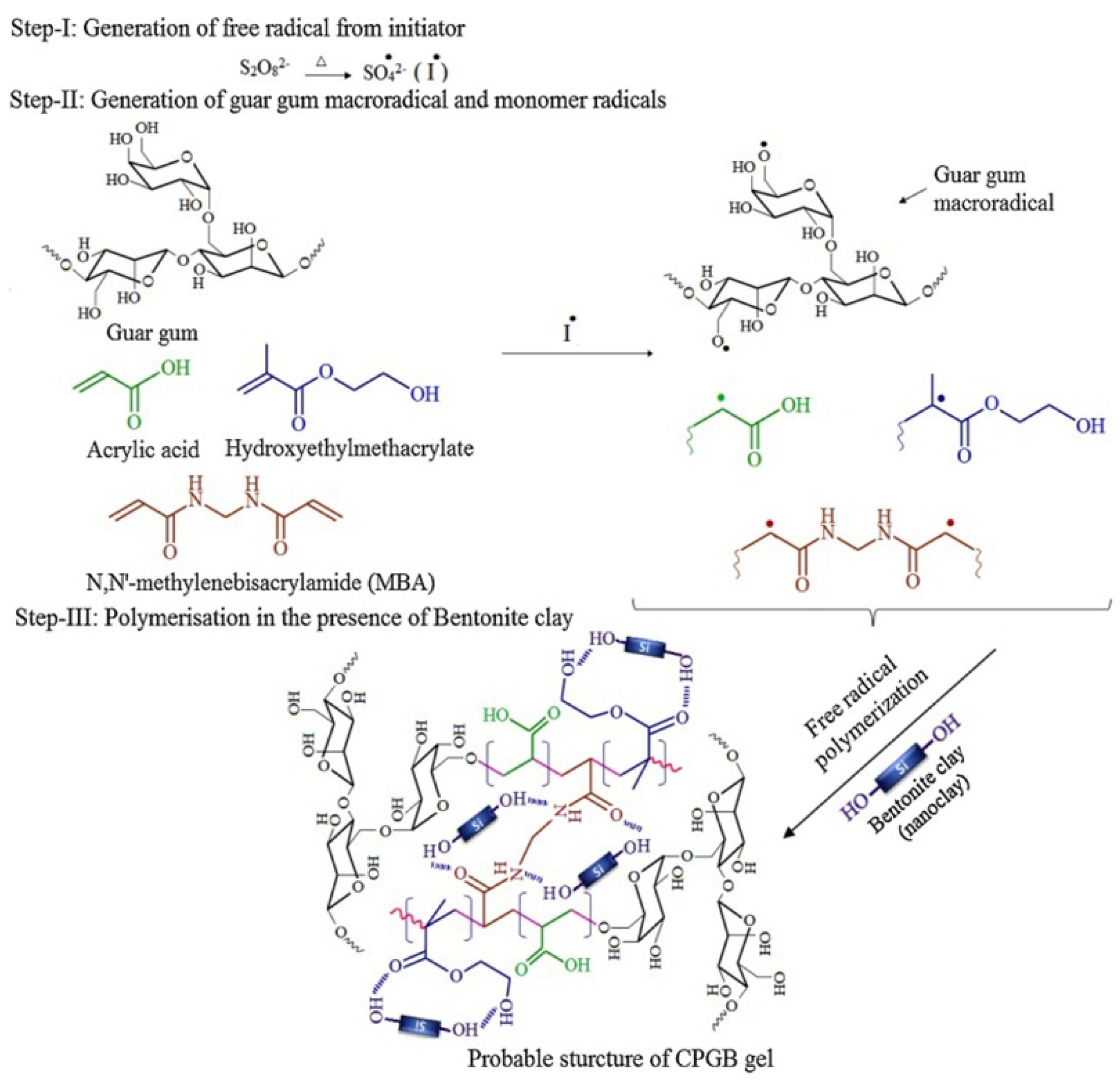
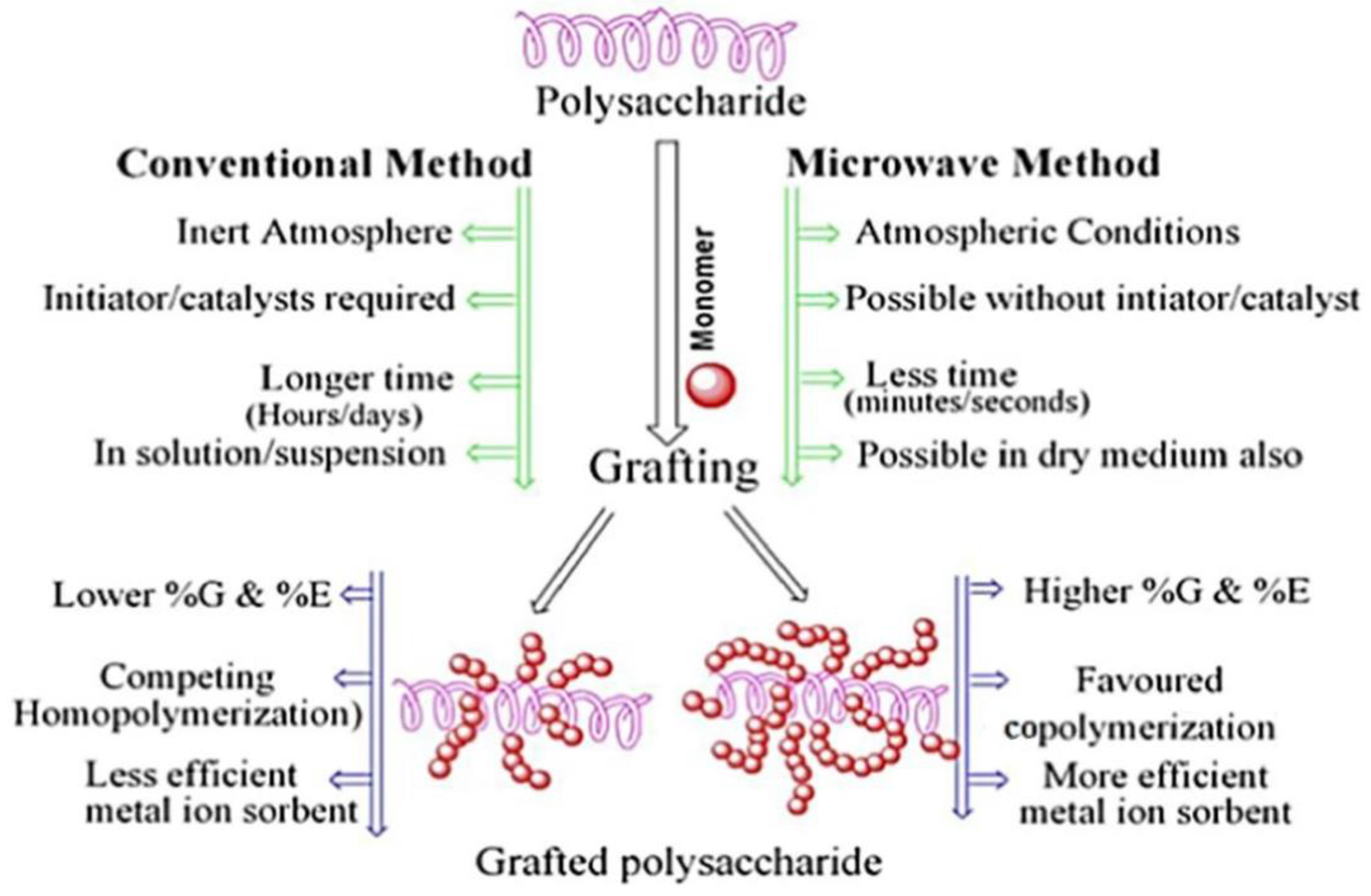
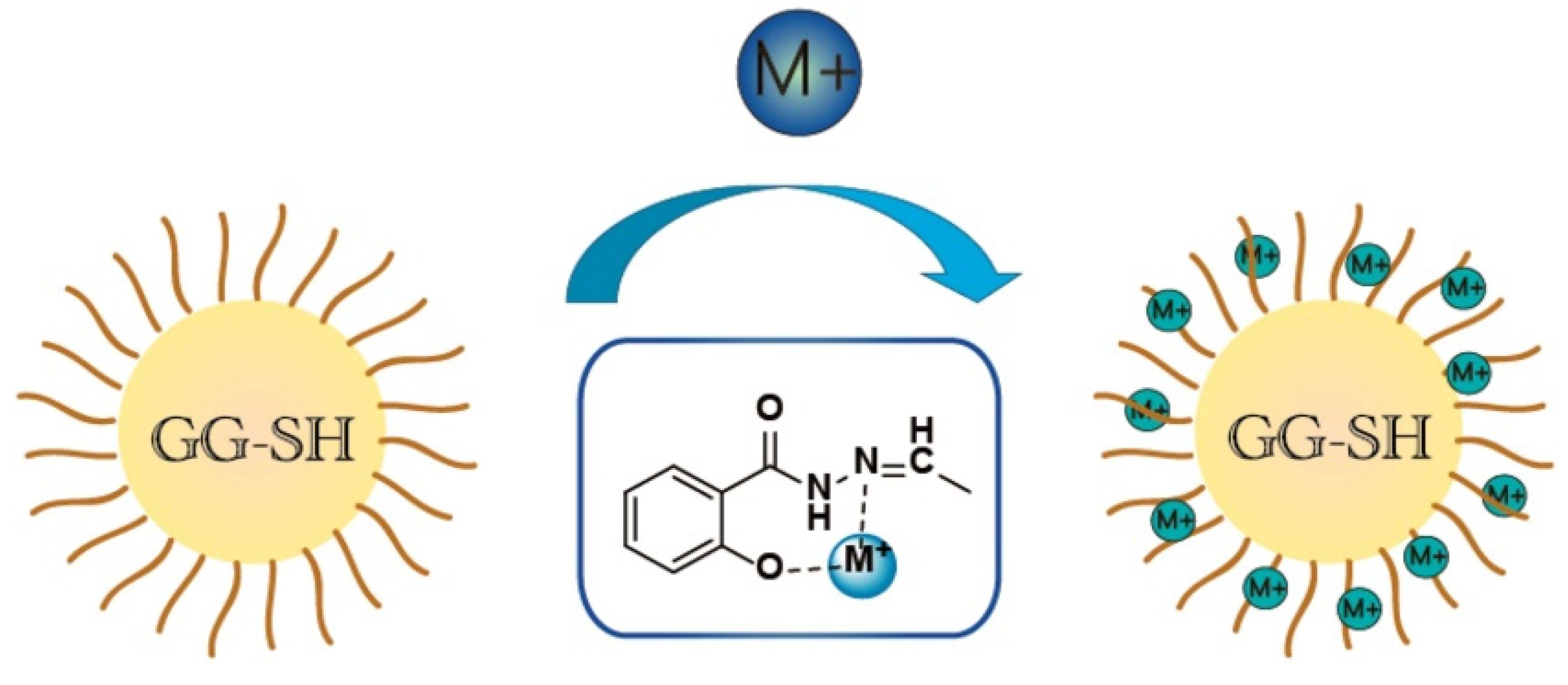
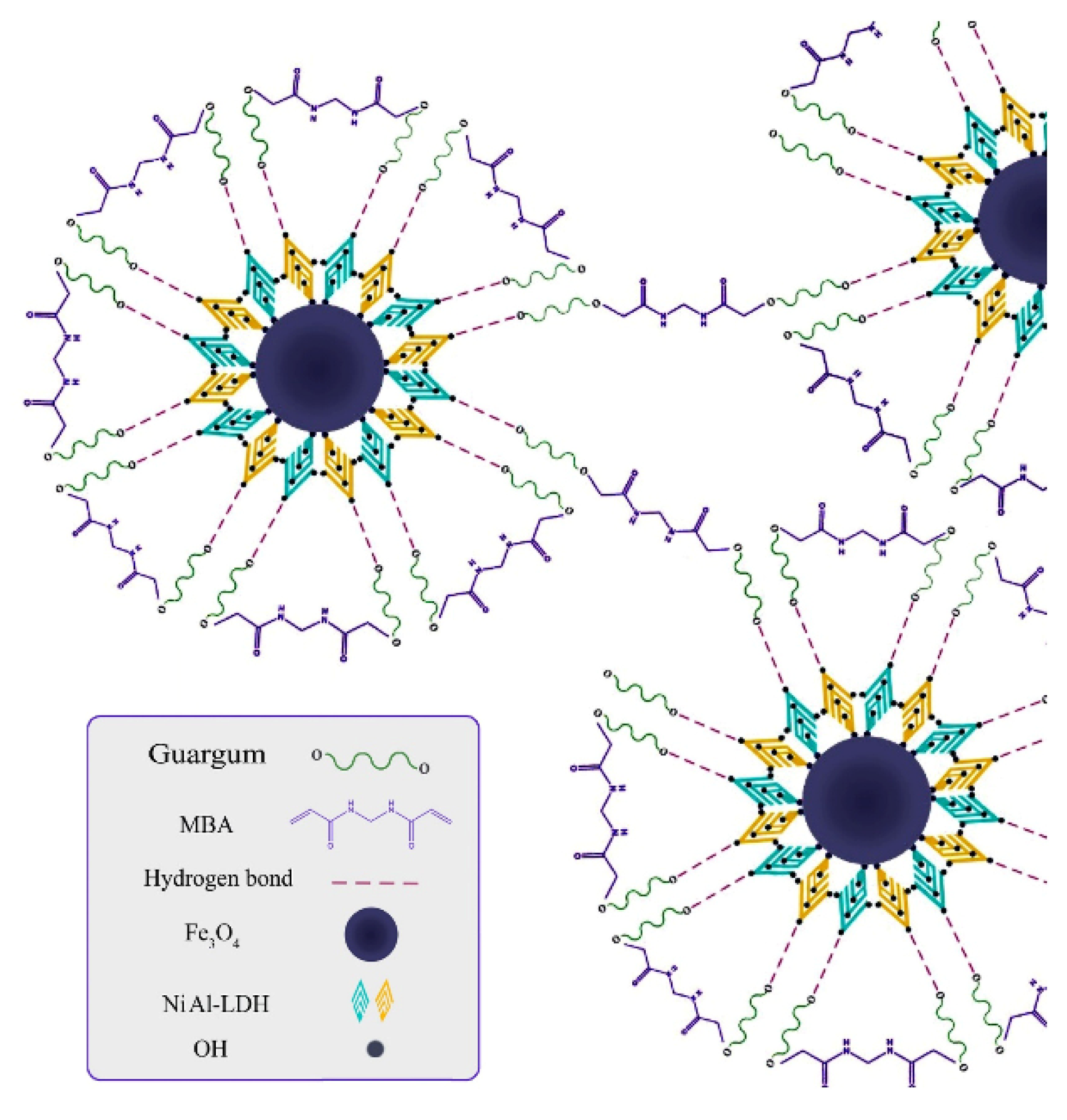

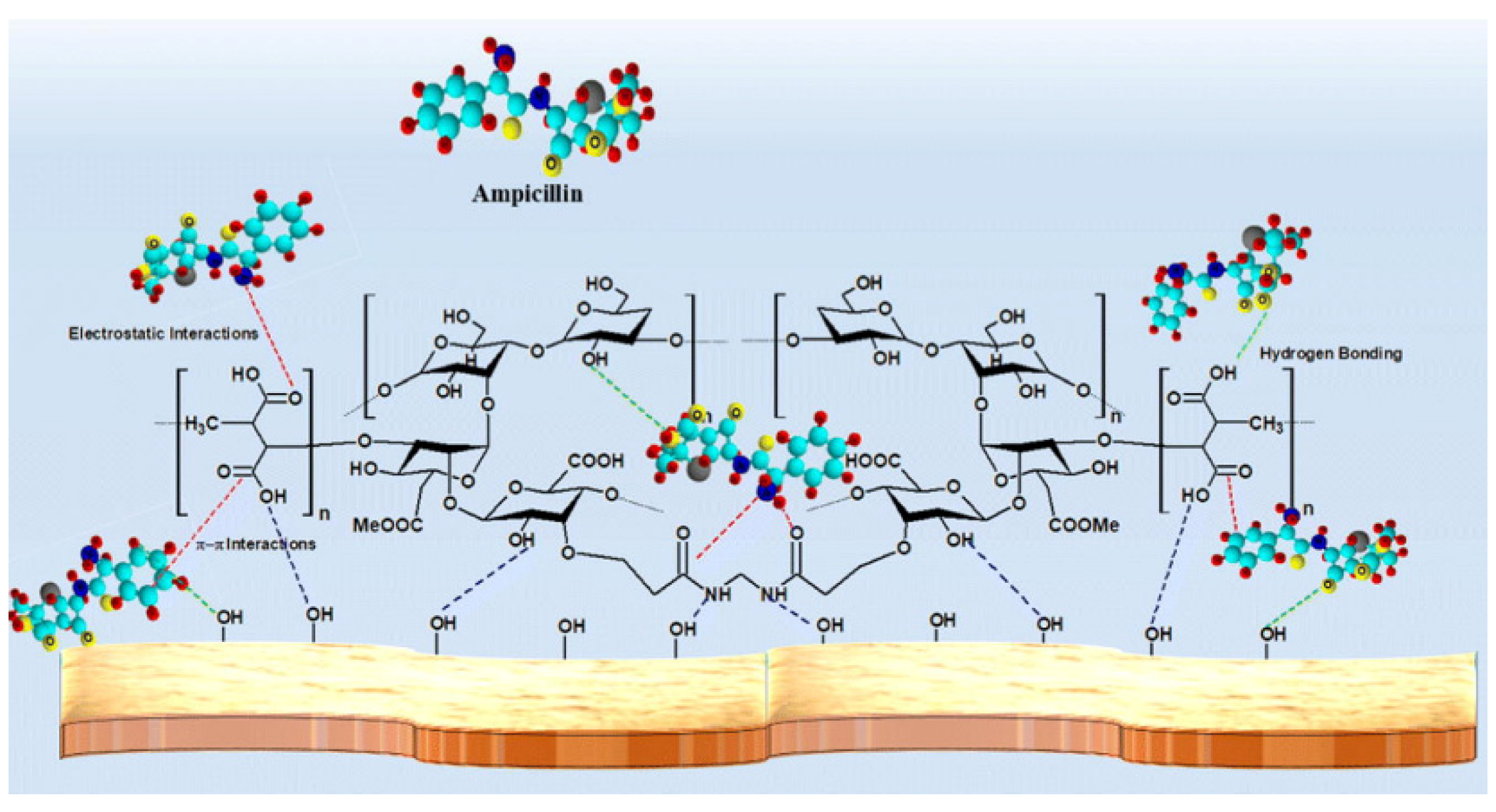


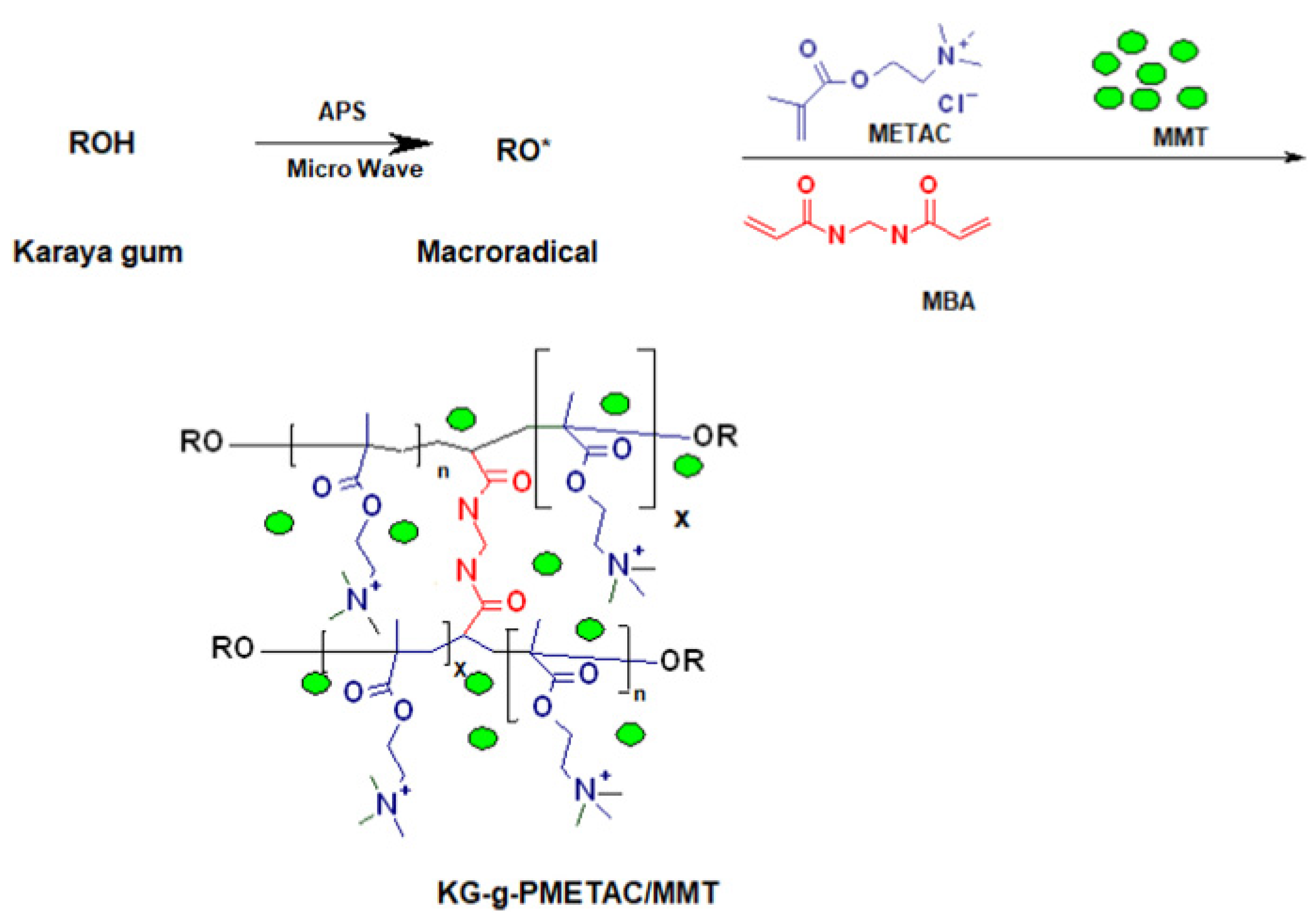

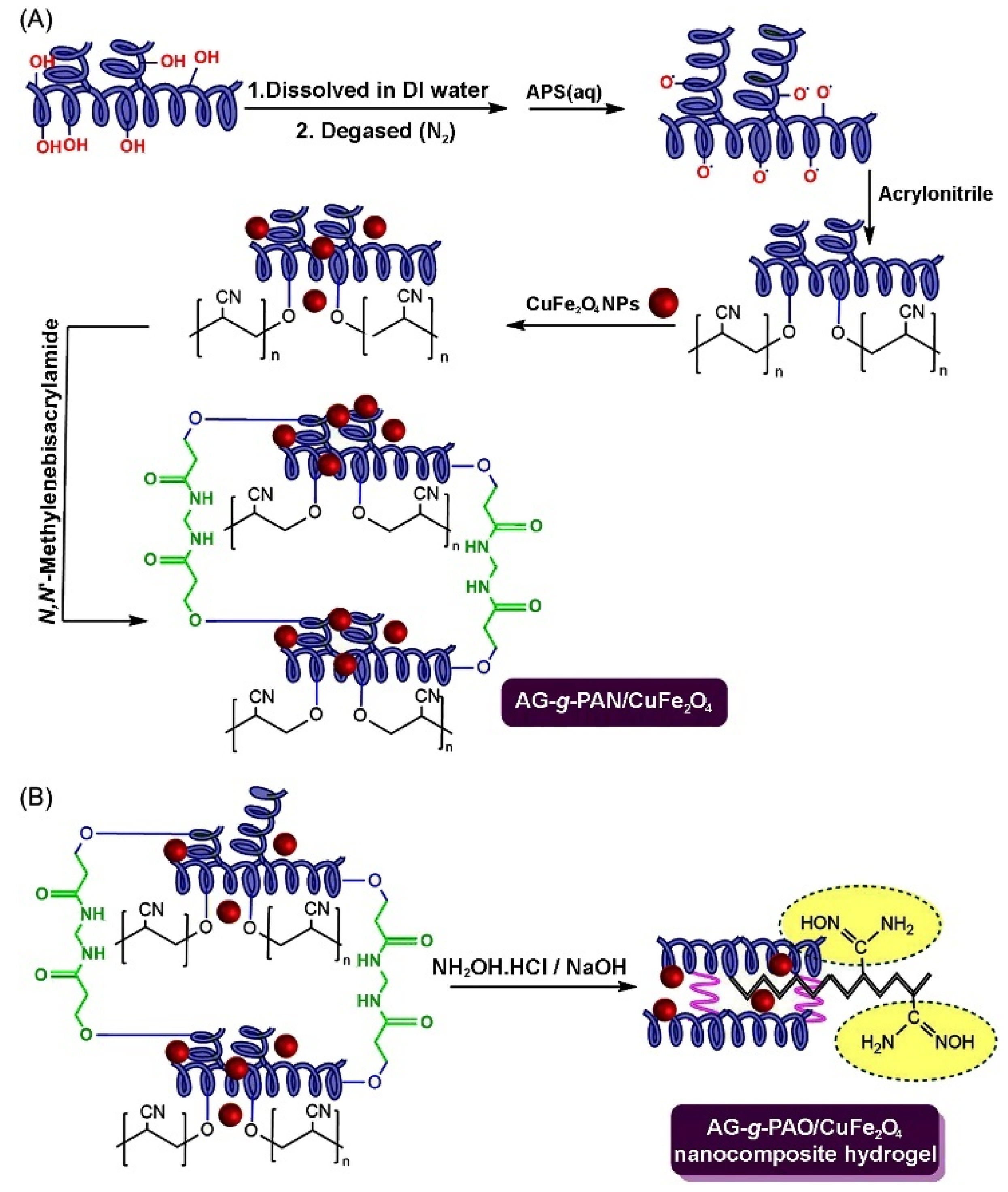
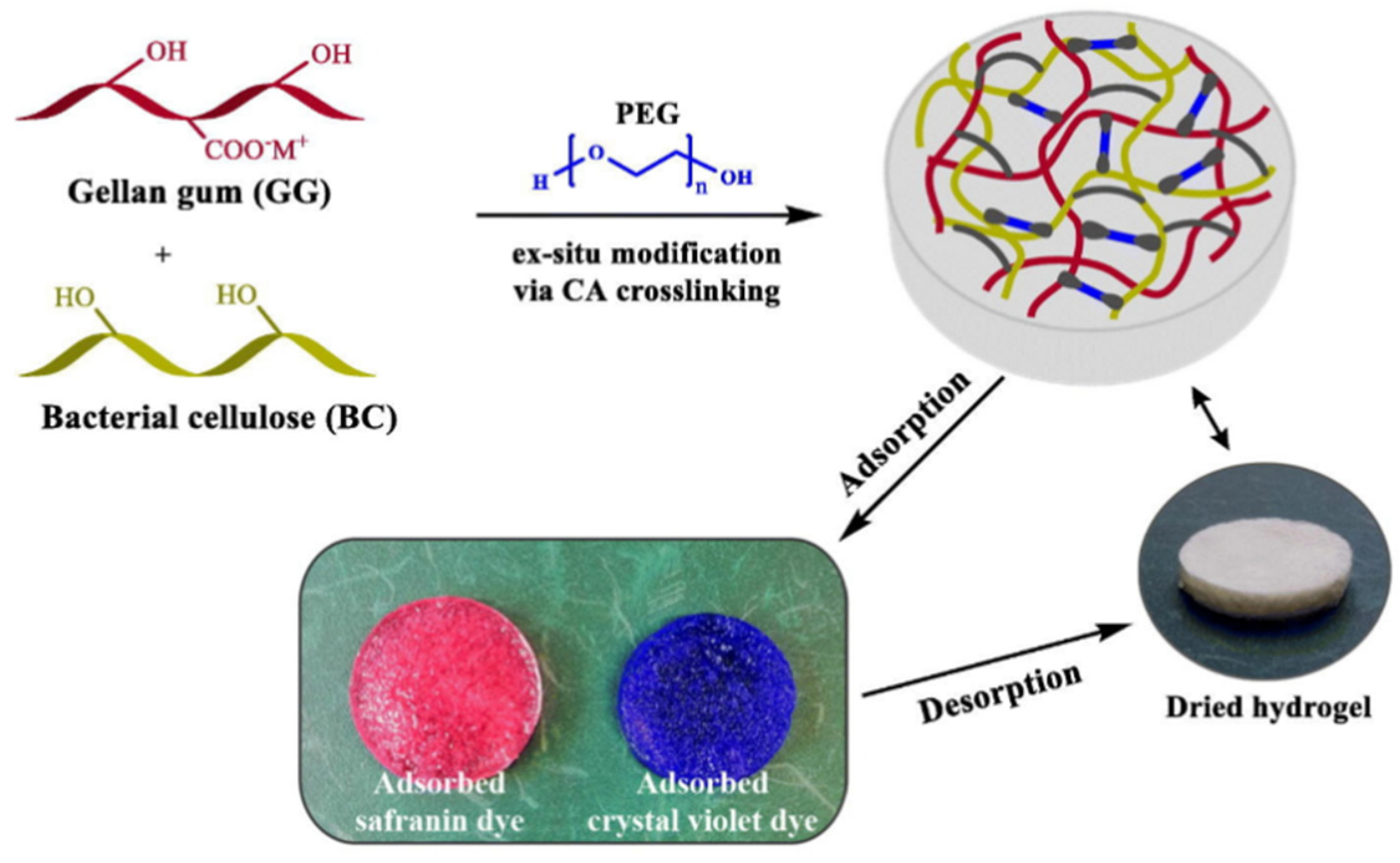
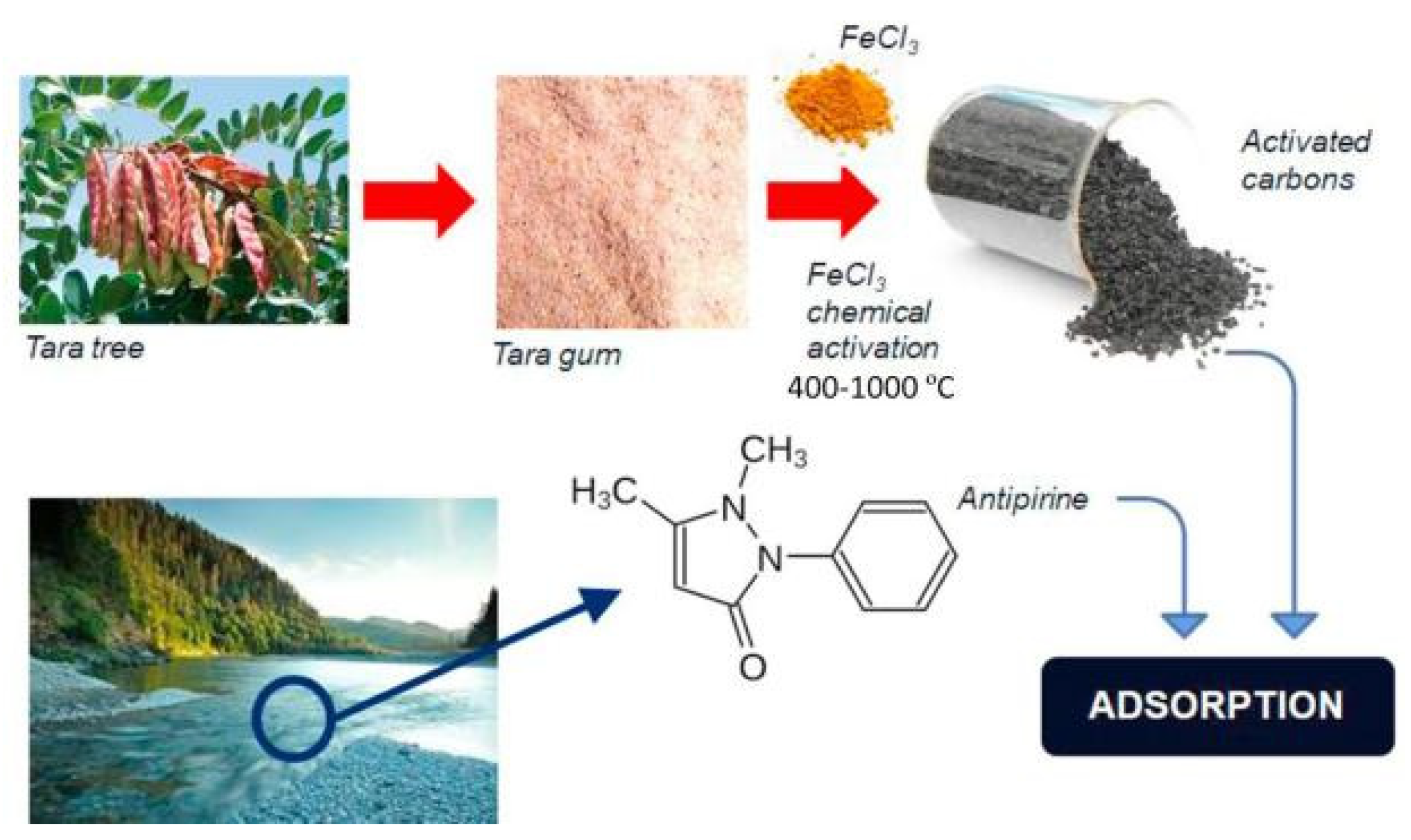

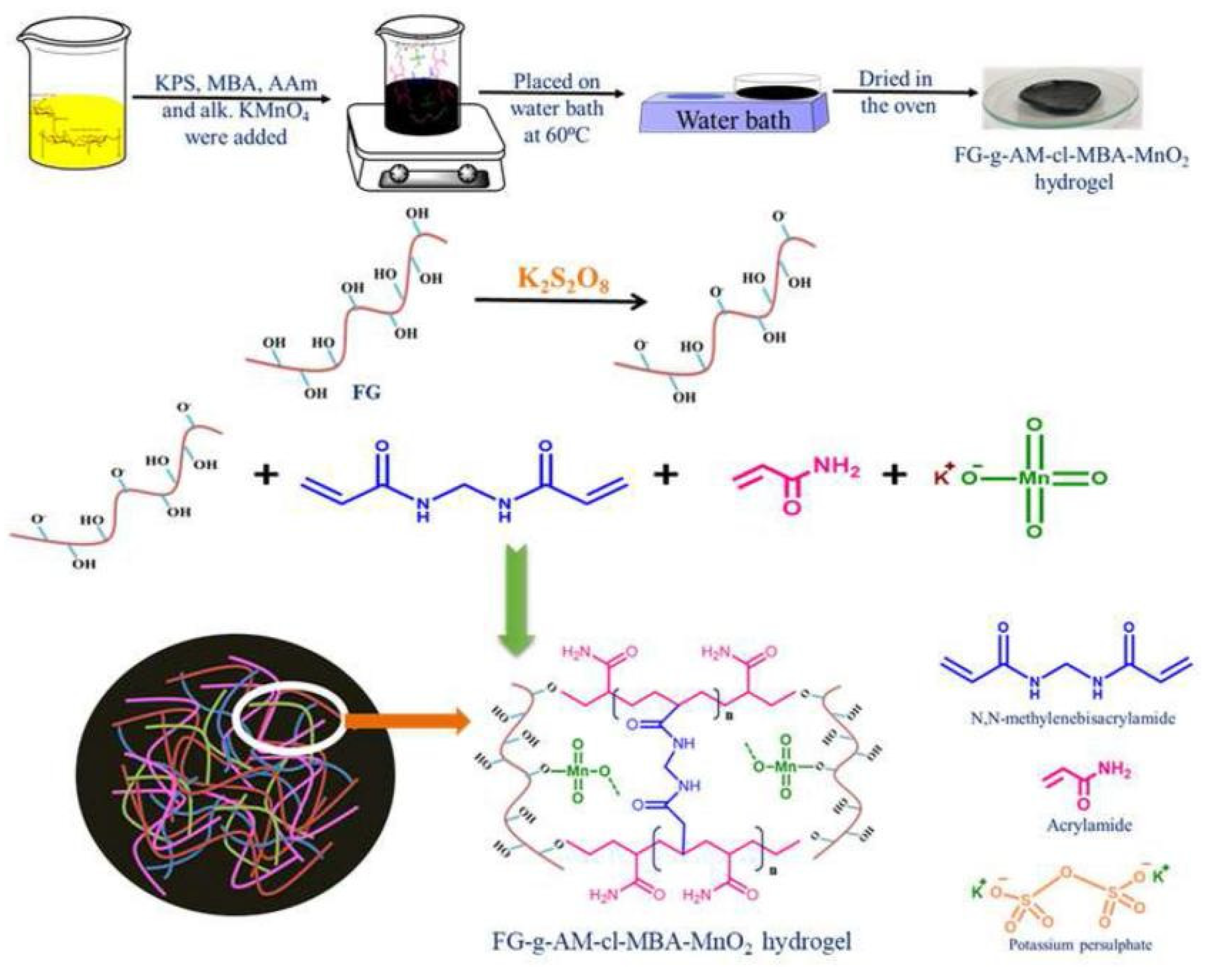
Disclaimer/Publisher’s Note: The statements, opinions and data contained in all publications are solely those of the individual author(s) and contributor(s) and not of MDPI and/or the editor(s). MDPI and/or the editor(s) disclaim responsibility for any injury to people or property resulting from any ideas, methods, instructions or products referred to in the content. |
© 2022 by the authors. Licensee MDPI, Basel, Switzerland. This article is an open access article distributed under the terms and conditions of the Creative Commons Attribution (CC BY) license (https://creativecommons.org/licenses/by/4.0/).
Share and Cite
Ge, H.; Ding, K.; Guo, F.; Wu, X.; Zhai, N.; Wang, W. Green and Superior Adsorbents Derived from Natural Plant Gums for Removal of Contaminants: A Review. Materials 2023, 16, 179. https://doi.org/10.3390/ma16010179
Ge H, Ding K, Guo F, Wu X, Zhai N, Wang W. Green and Superior Adsorbents Derived from Natural Plant Gums for Removal of Contaminants: A Review. Materials. 2023; 16(1):179. https://doi.org/10.3390/ma16010179
Chicago/Turabian StyleGe, Hanwen, Ke Ding, Fang Guo, Xianli Wu, Naihua Zhai, and Wenbo Wang. 2023. "Green and Superior Adsorbents Derived from Natural Plant Gums for Removal of Contaminants: A Review" Materials 16, no. 1: 179. https://doi.org/10.3390/ma16010179
APA StyleGe, H., Ding, K., Guo, F., Wu, X., Zhai, N., & Wang, W. (2023). Green and Superior Adsorbents Derived from Natural Plant Gums for Removal of Contaminants: A Review. Materials, 16(1), 179. https://doi.org/10.3390/ma16010179







